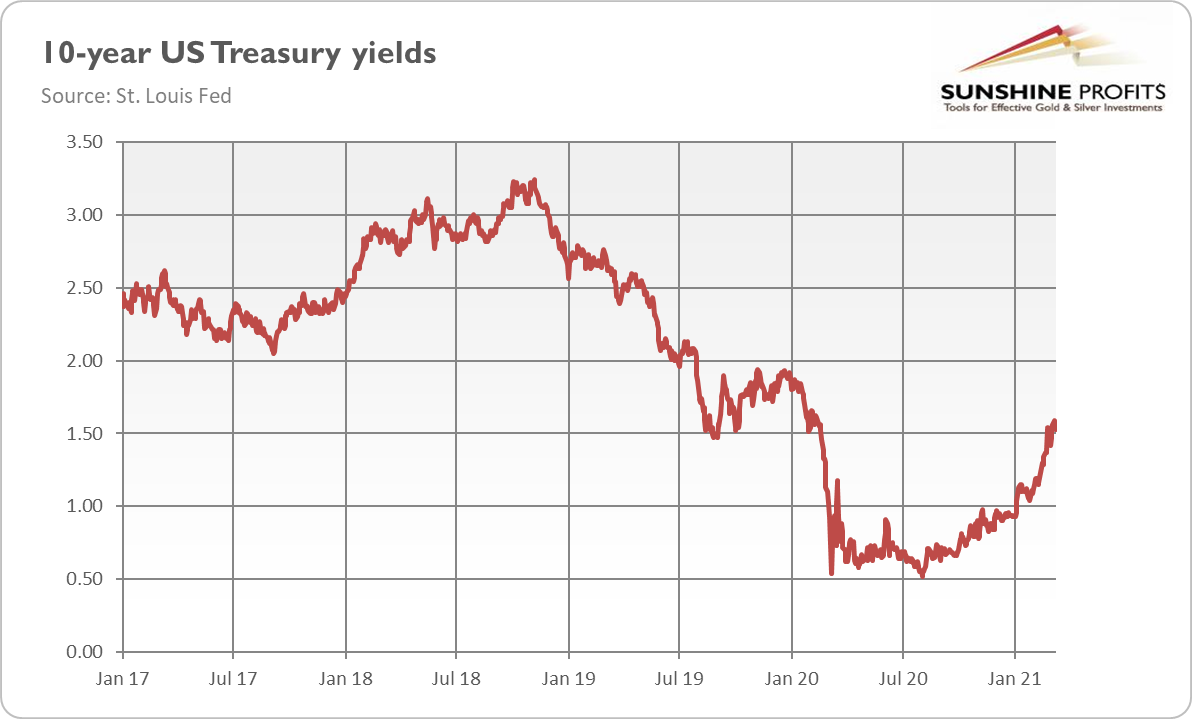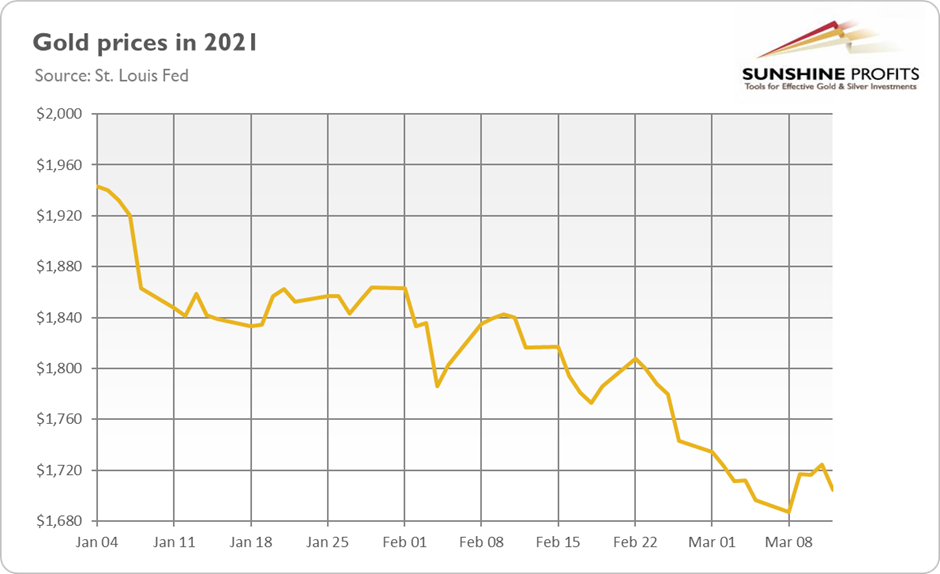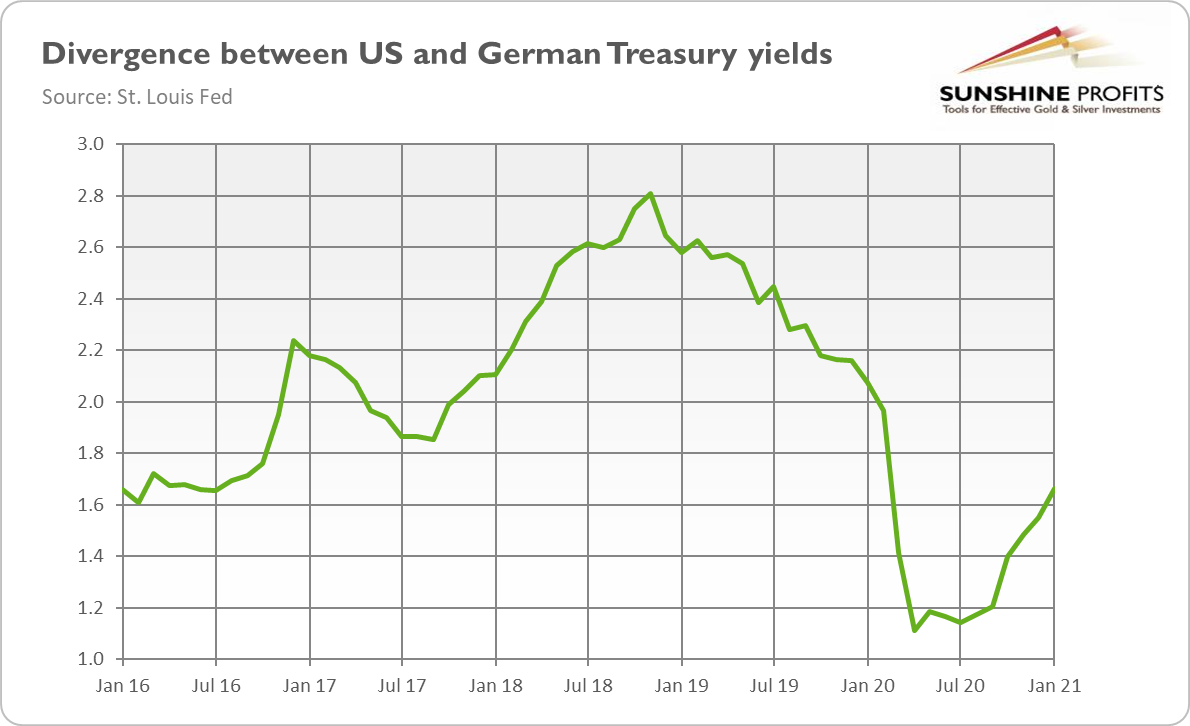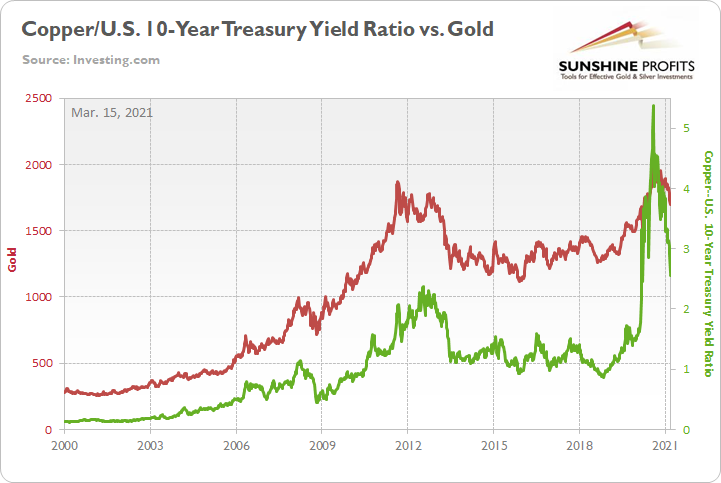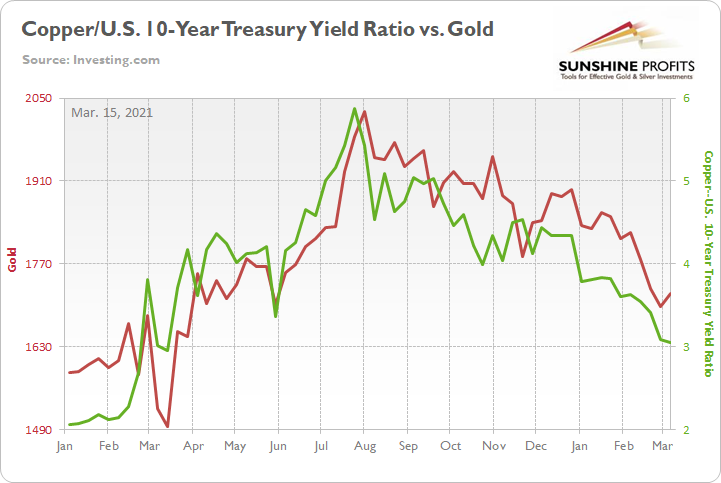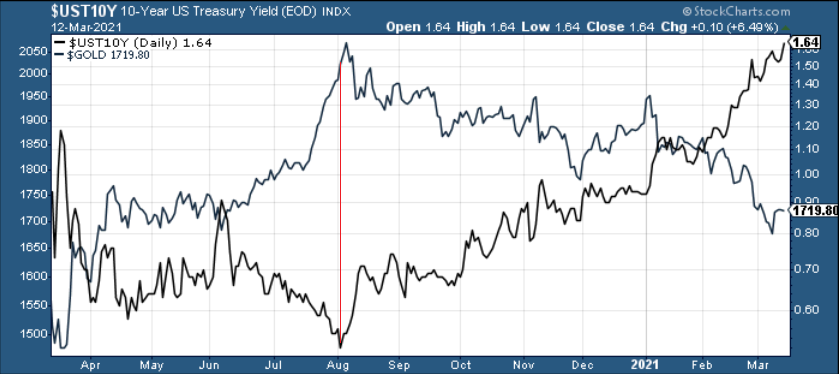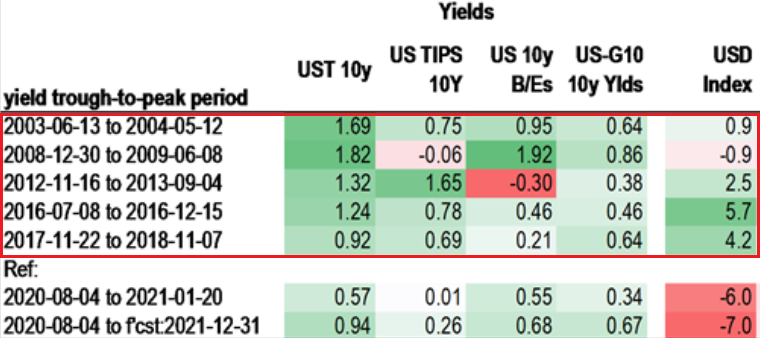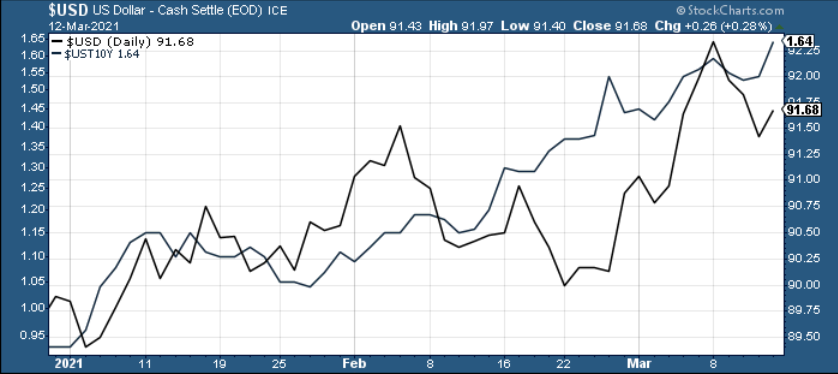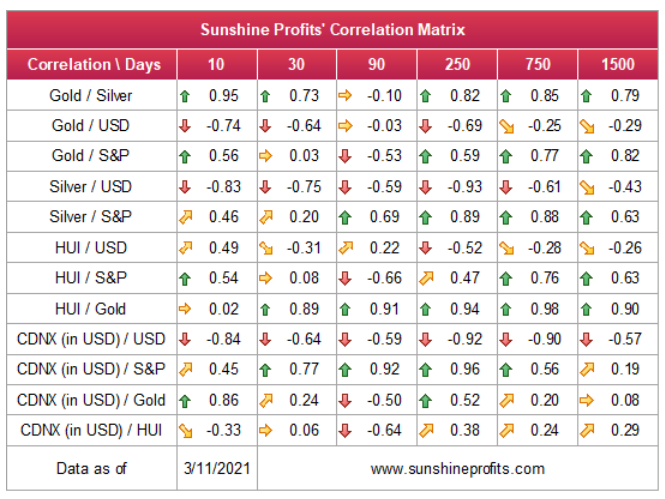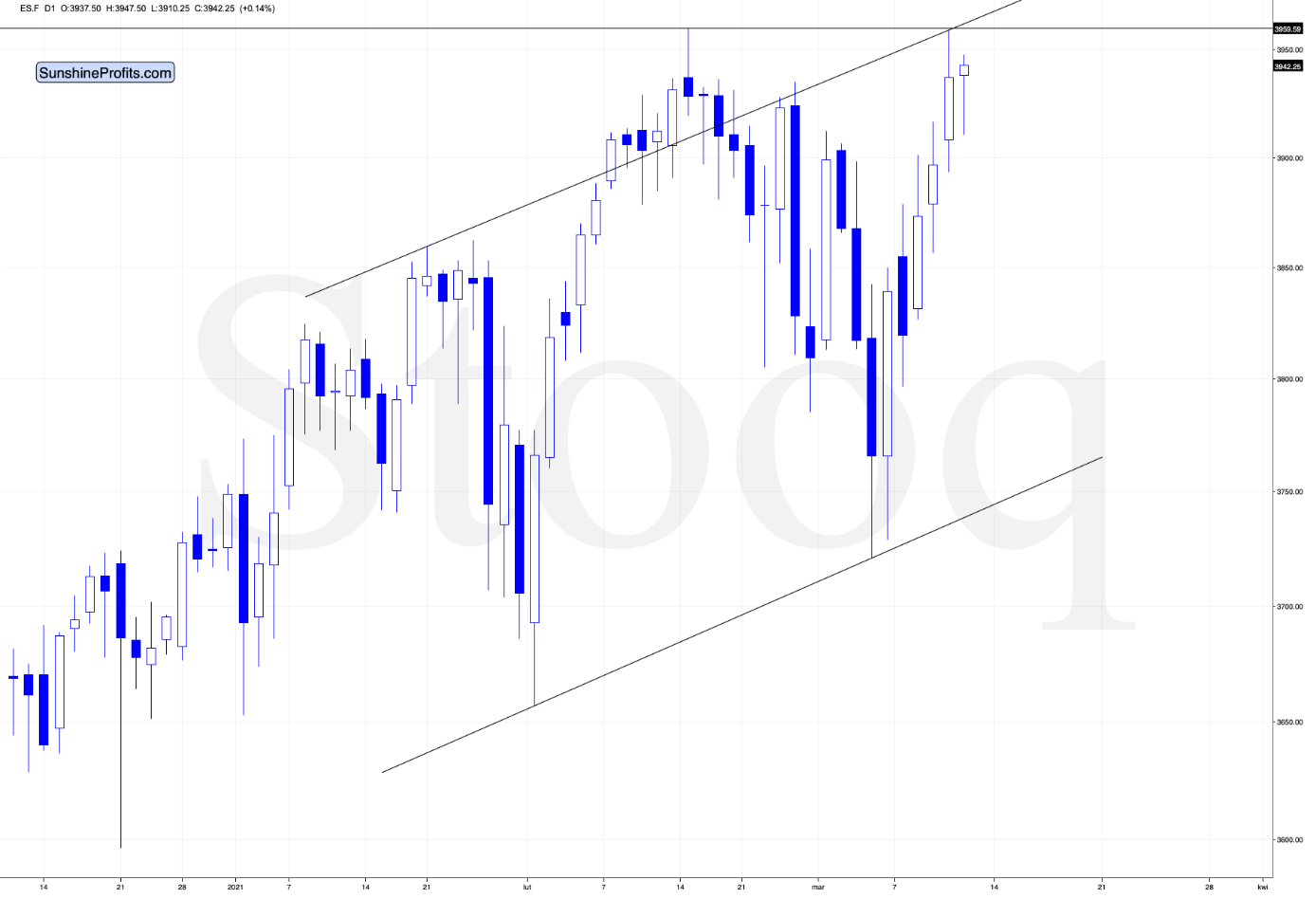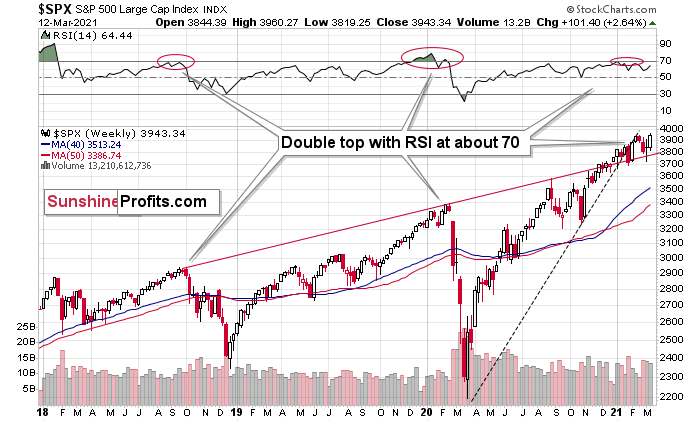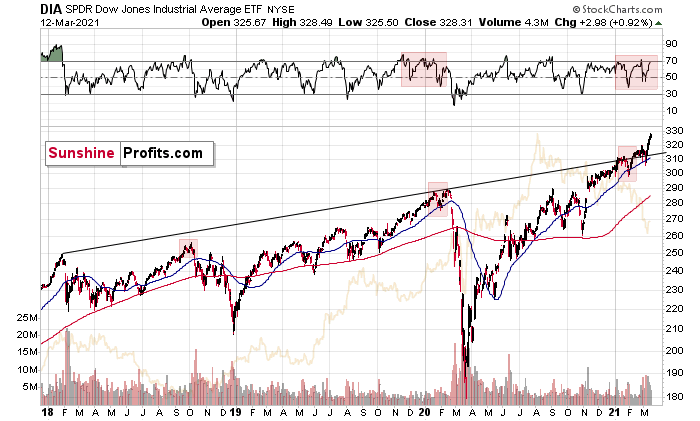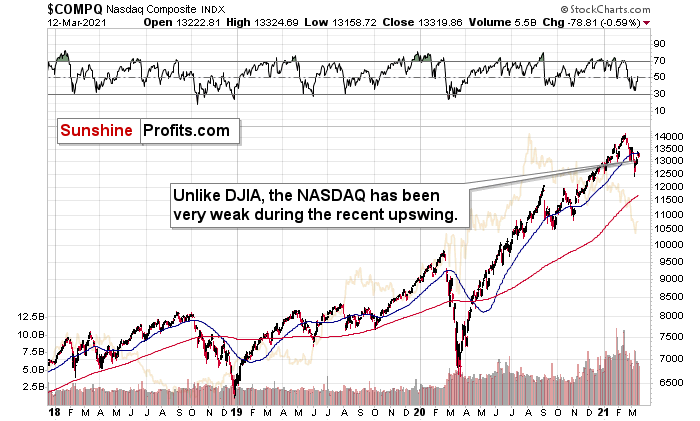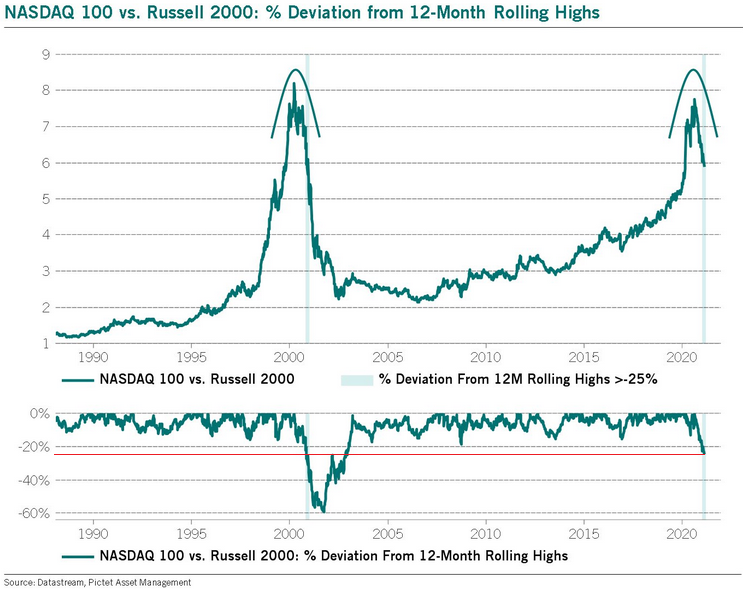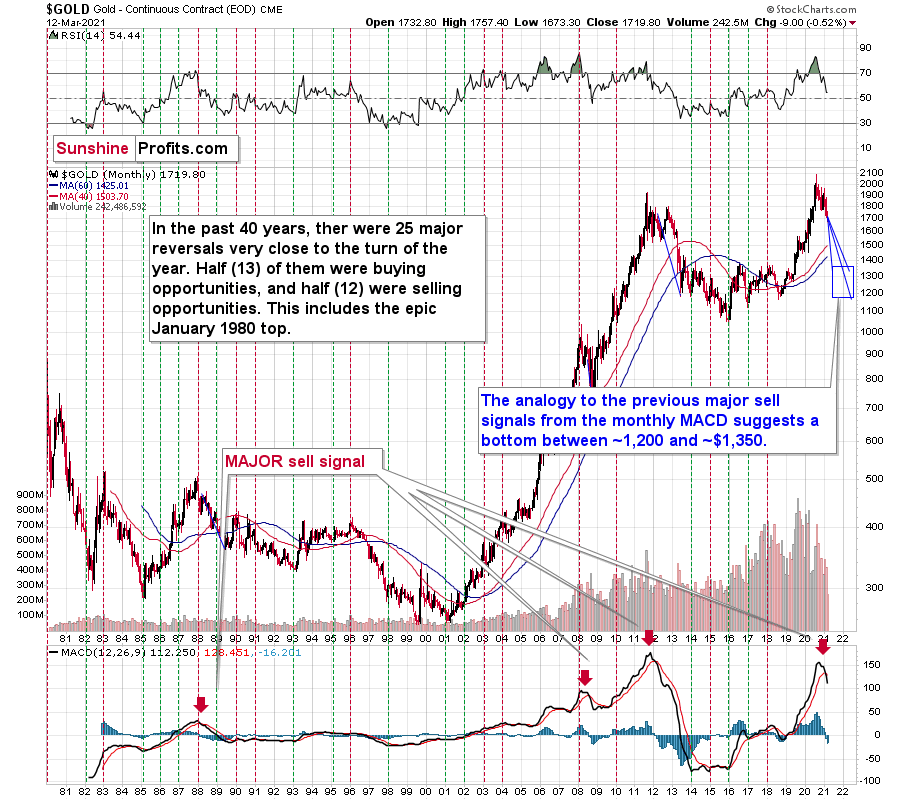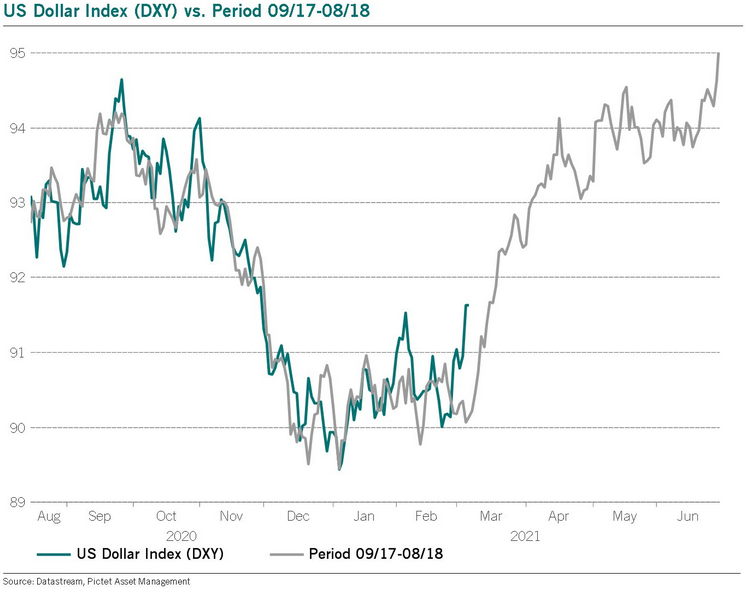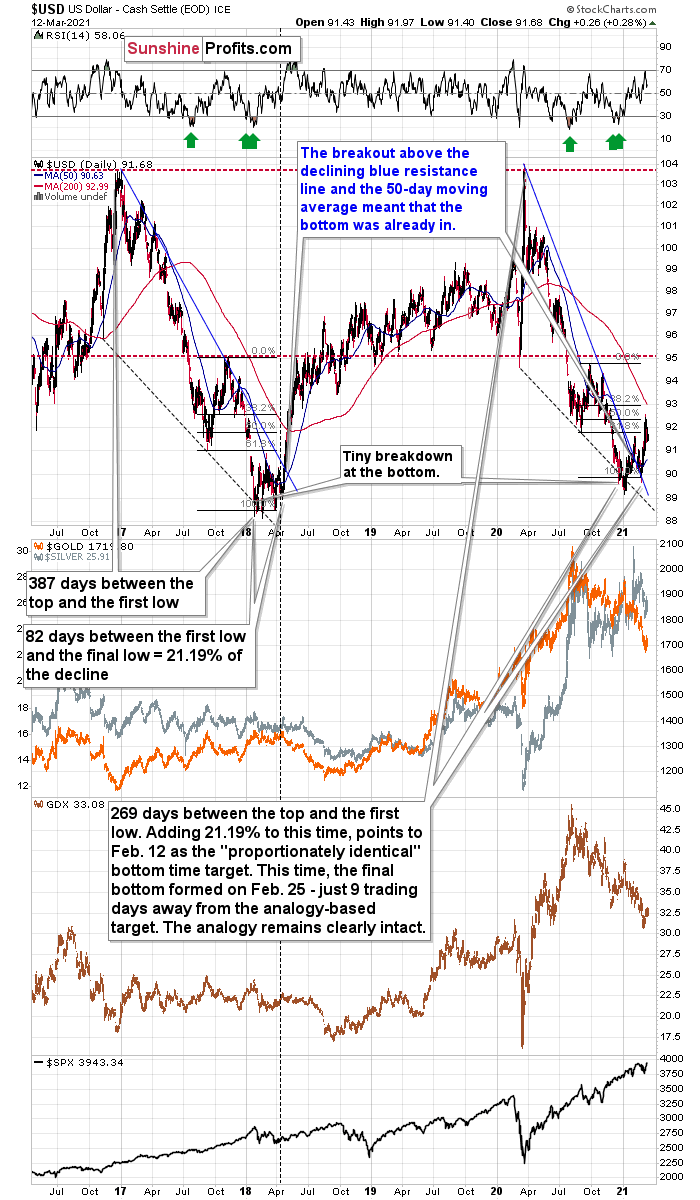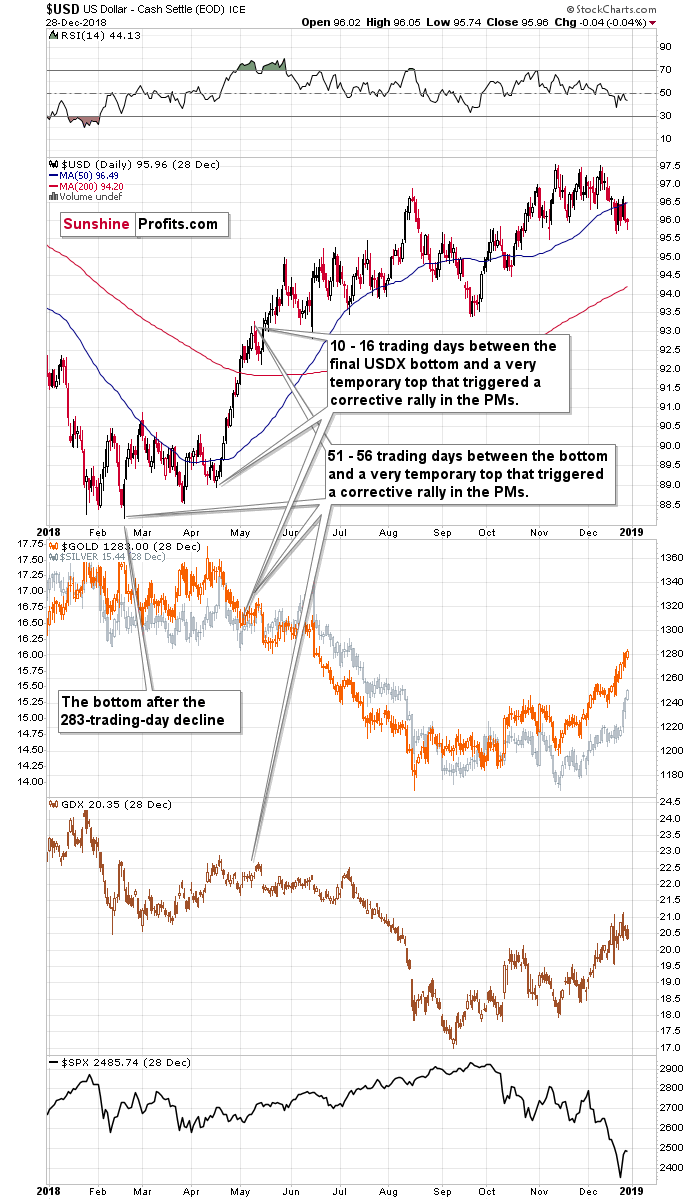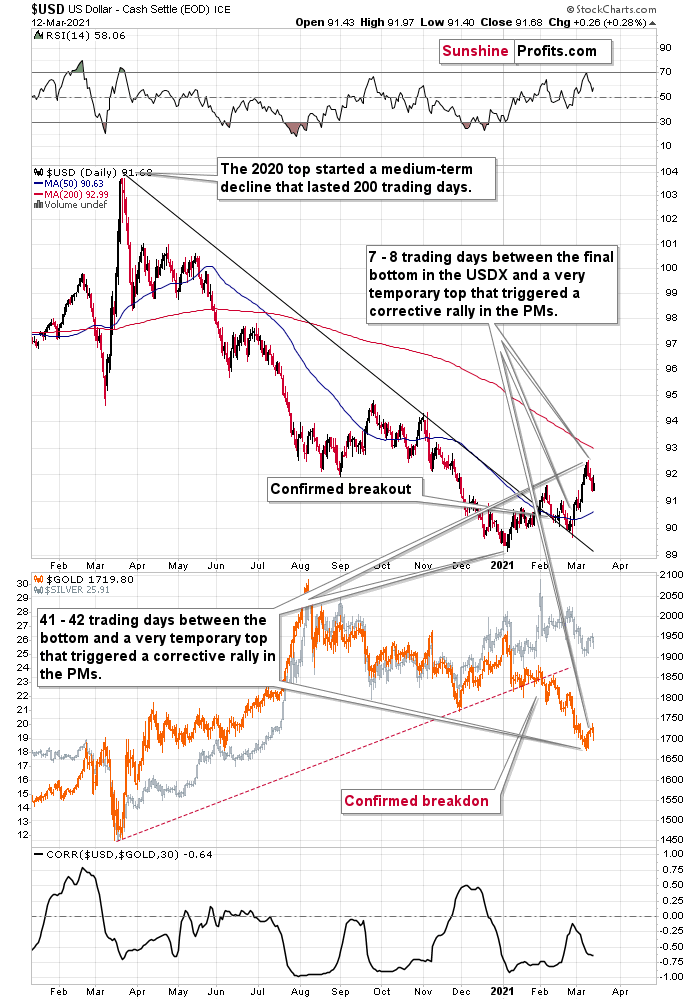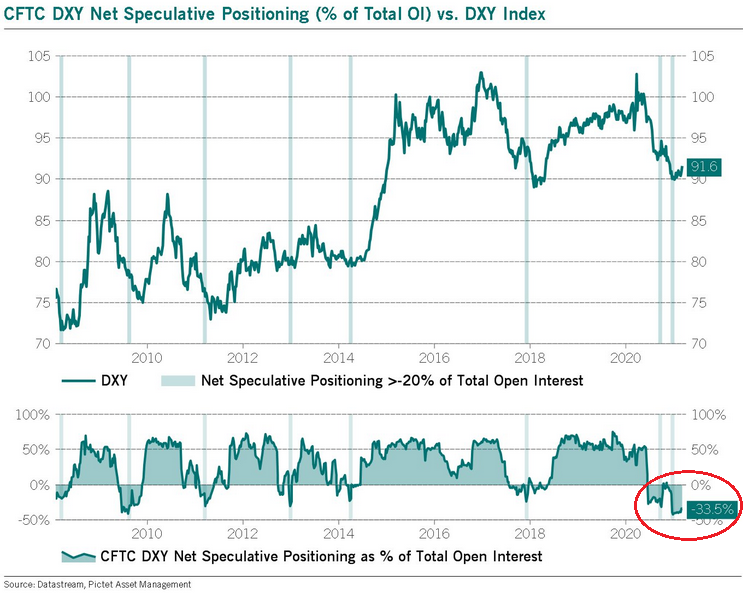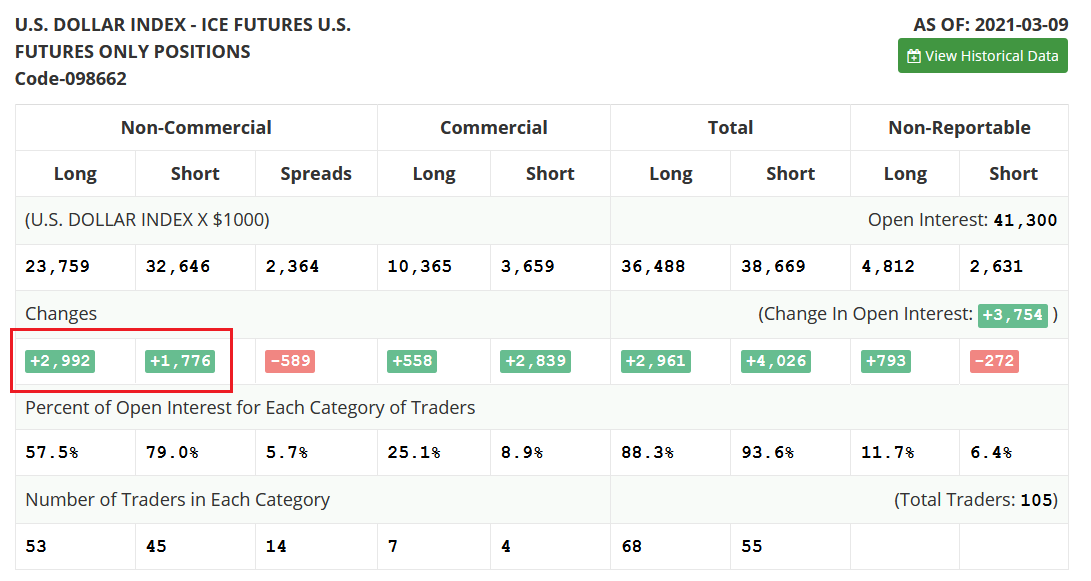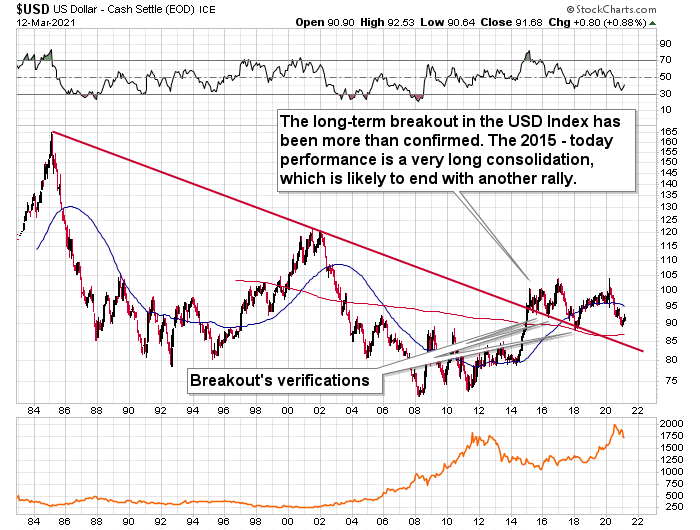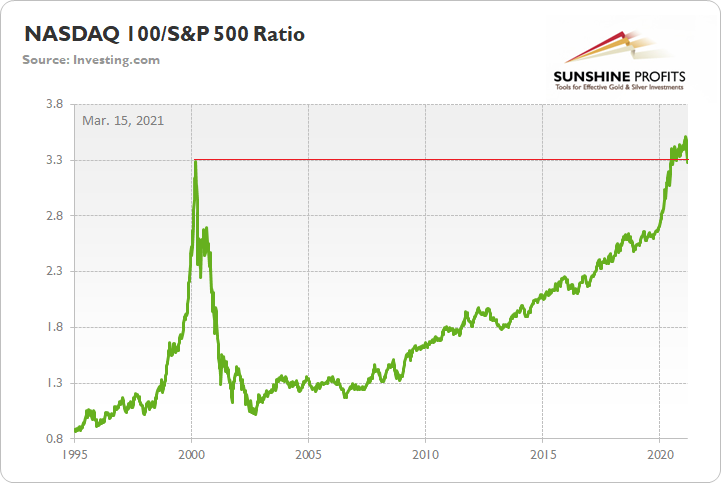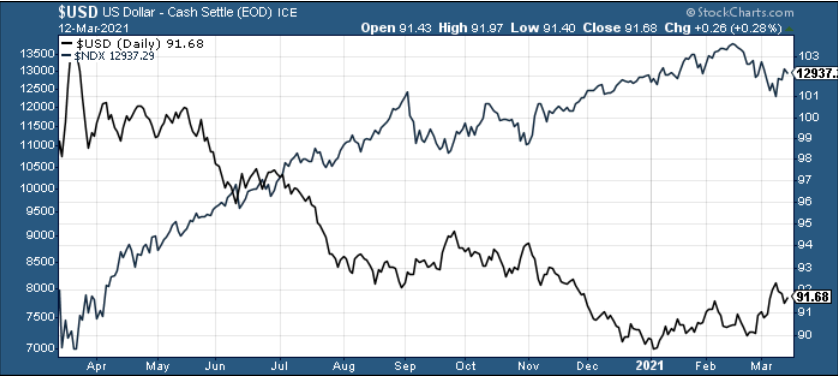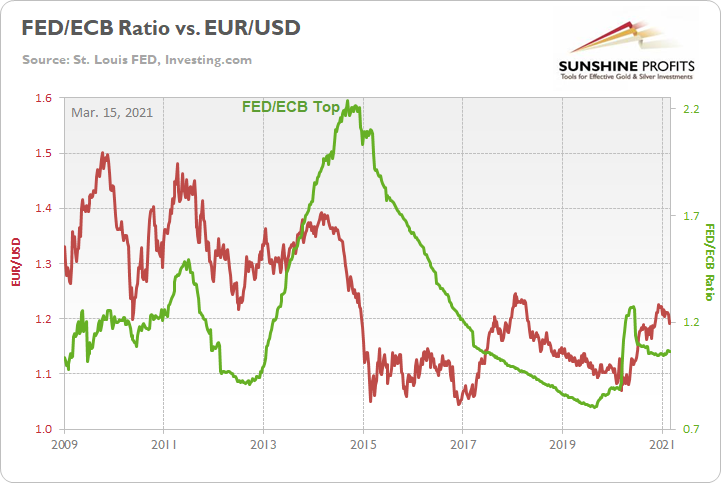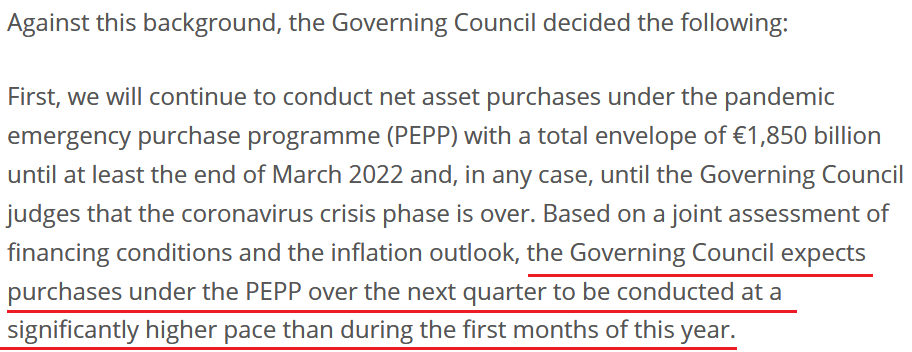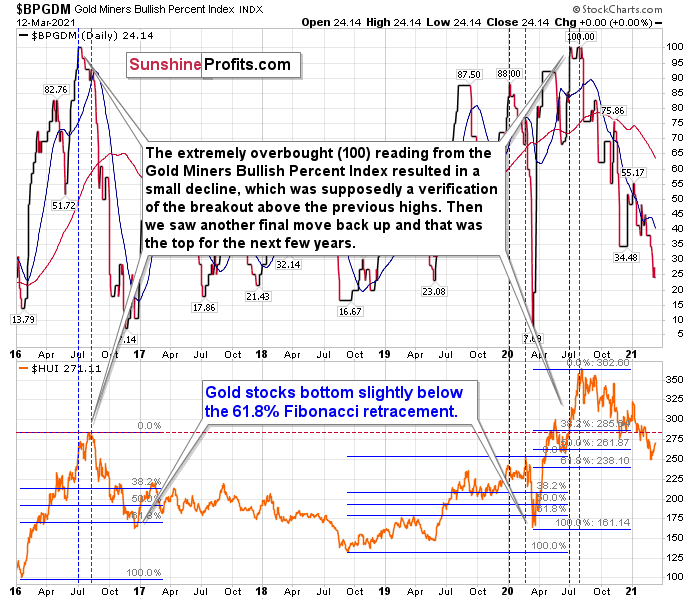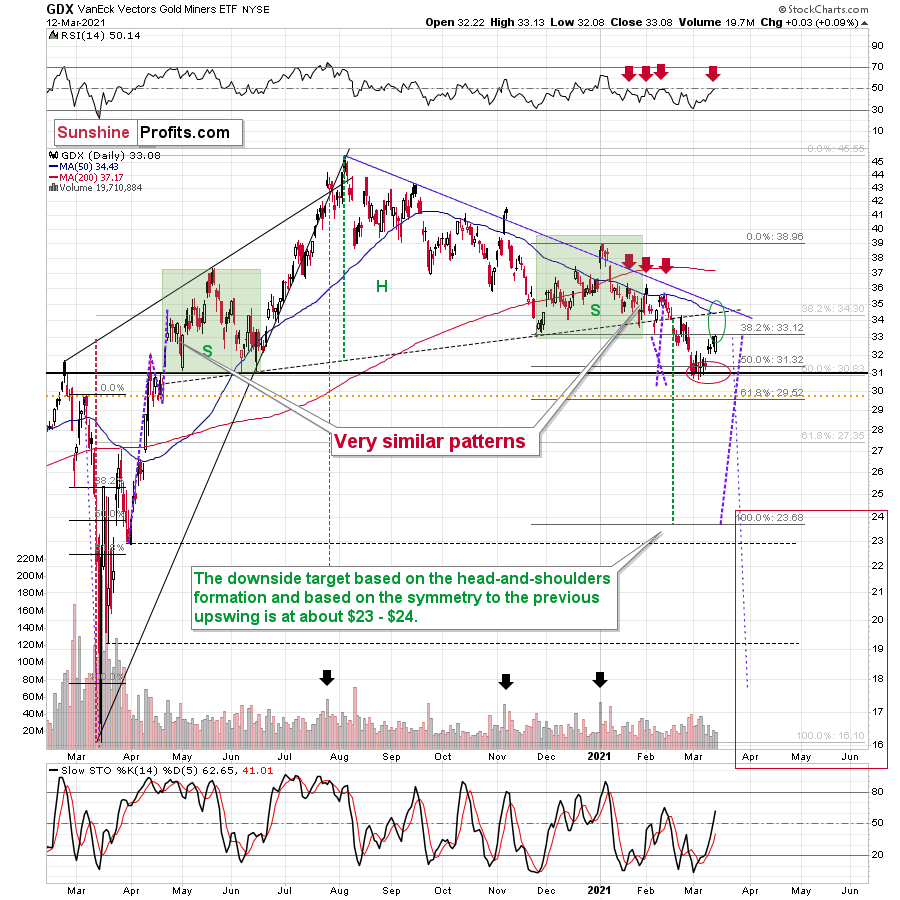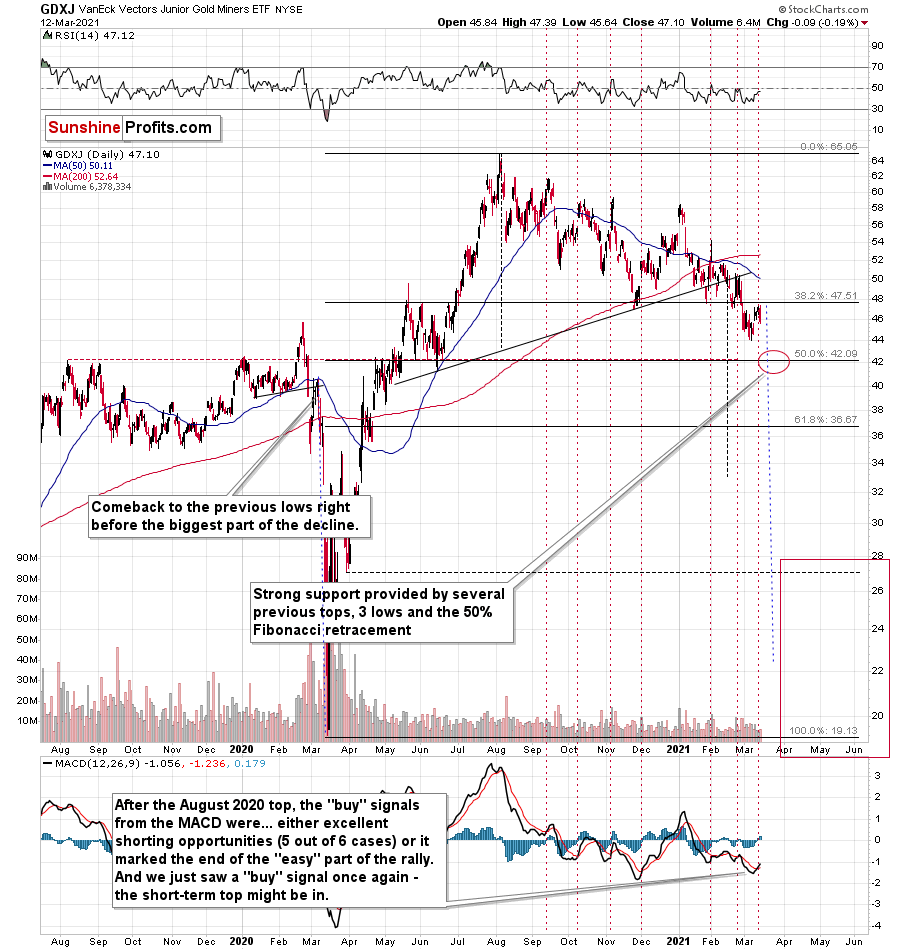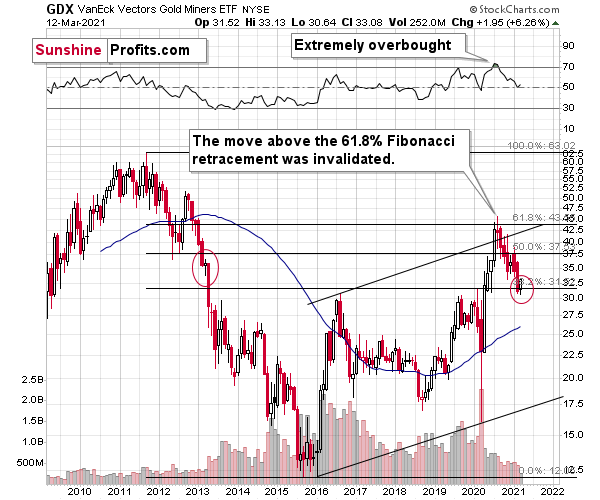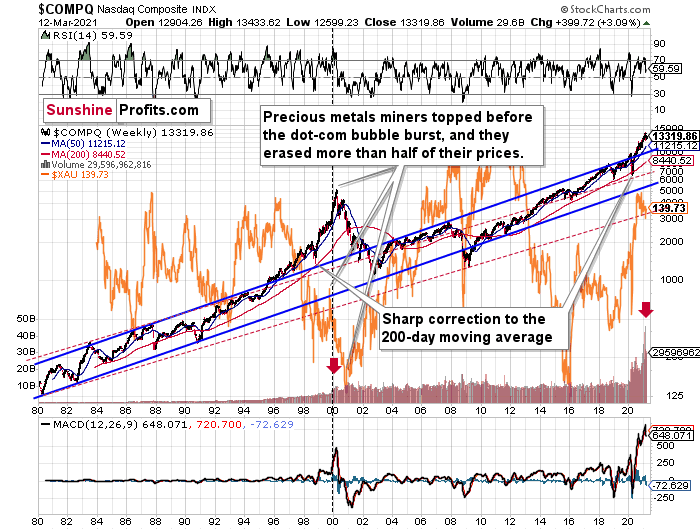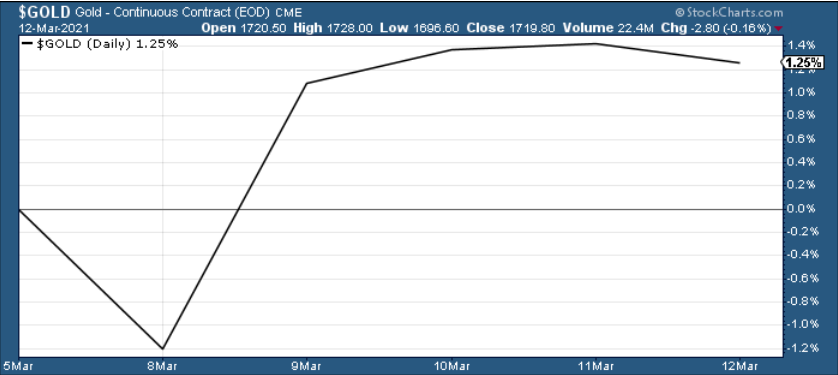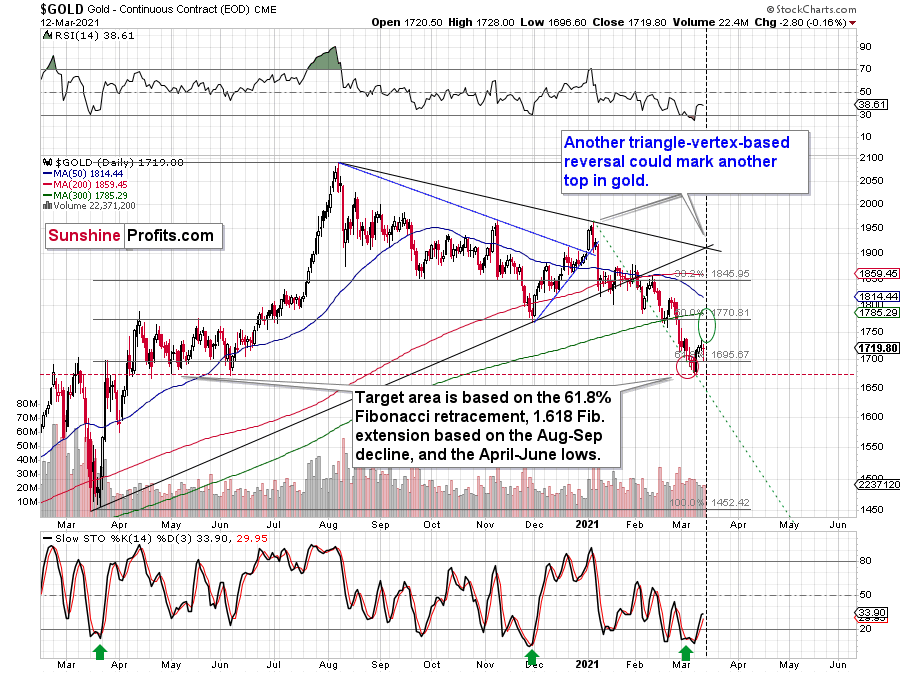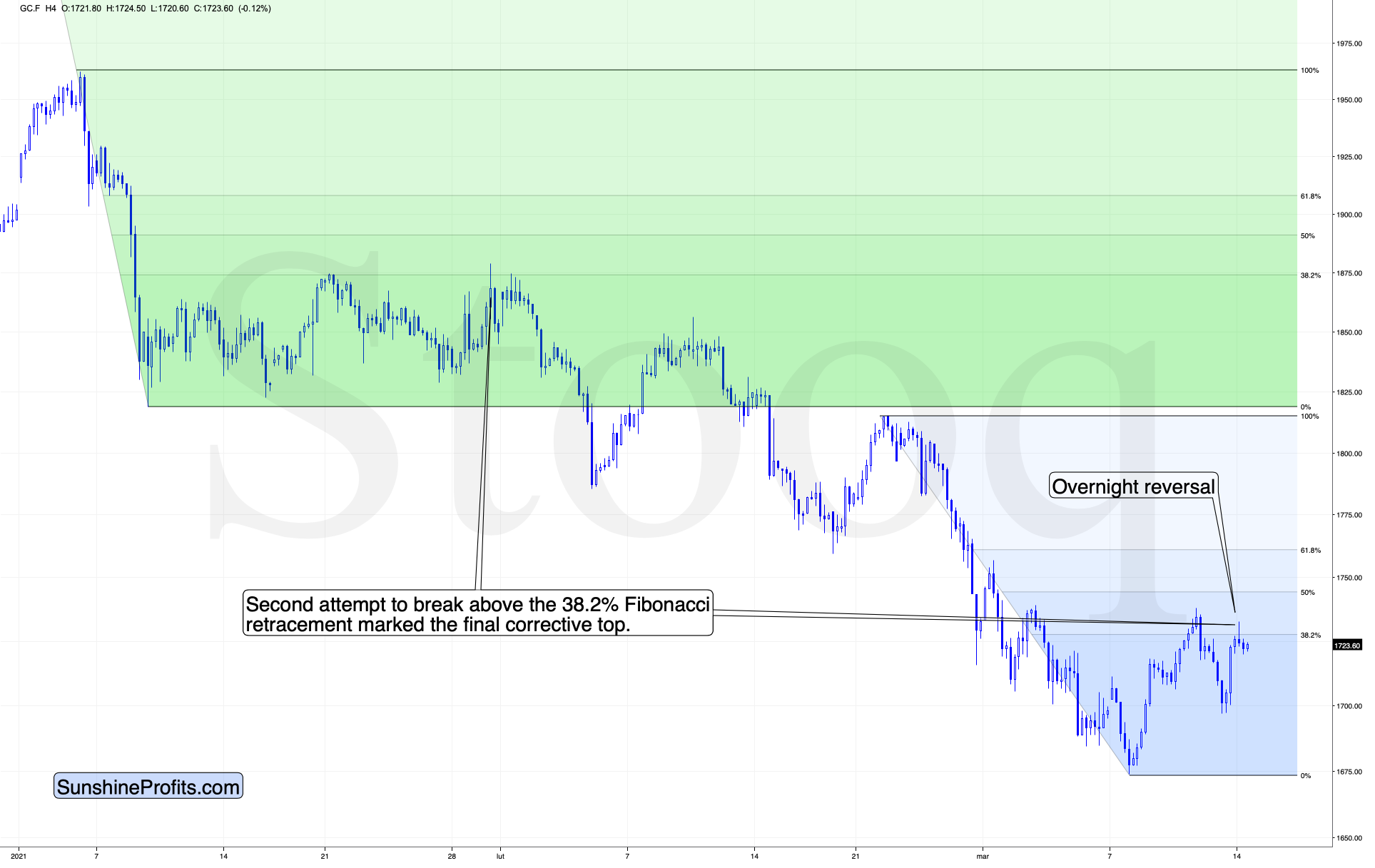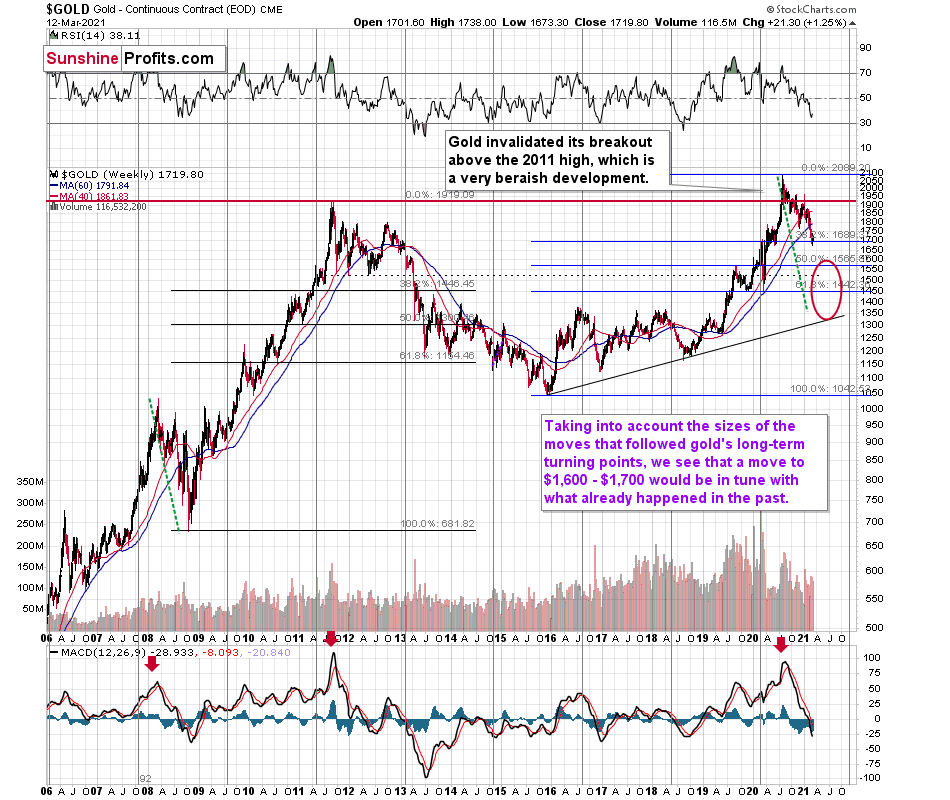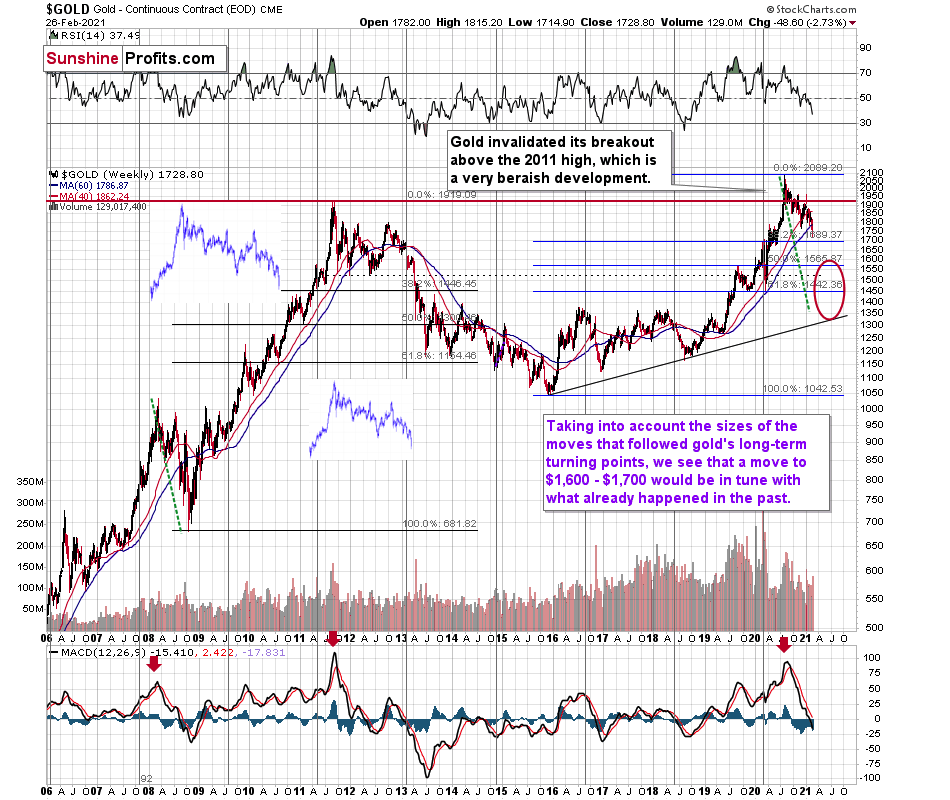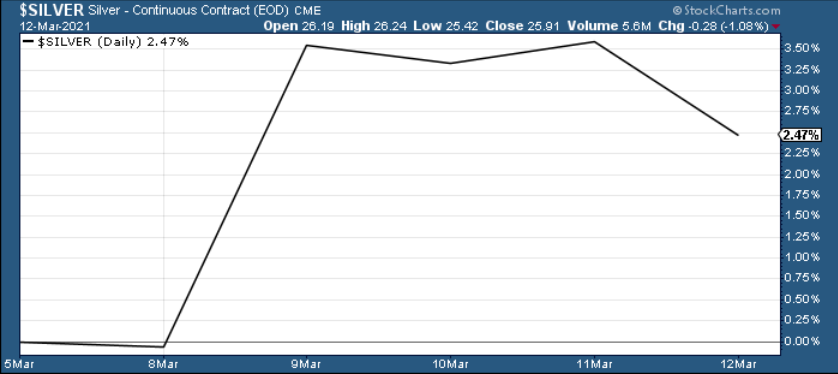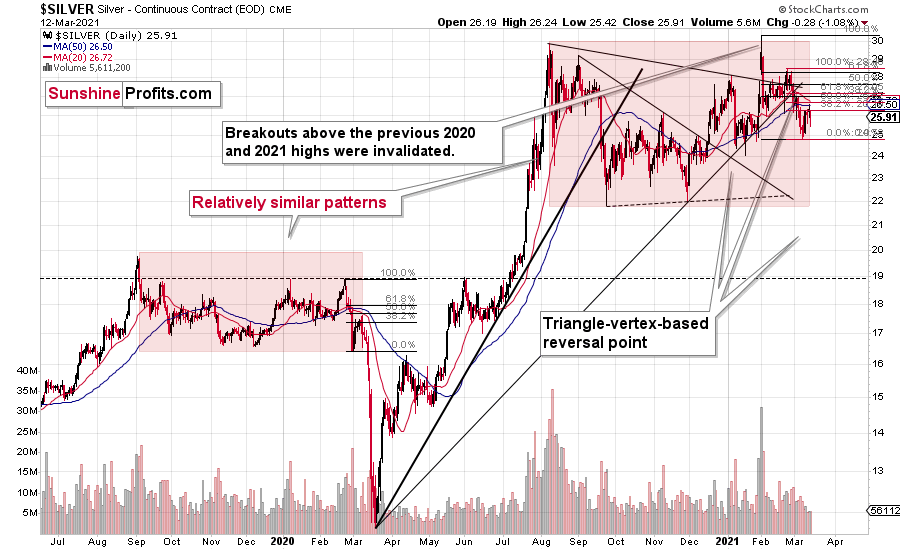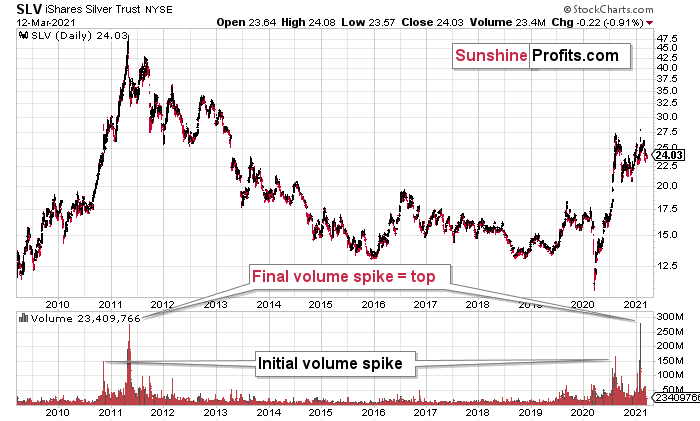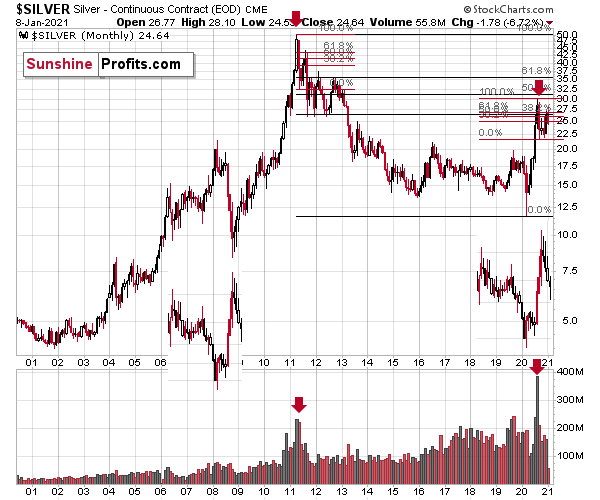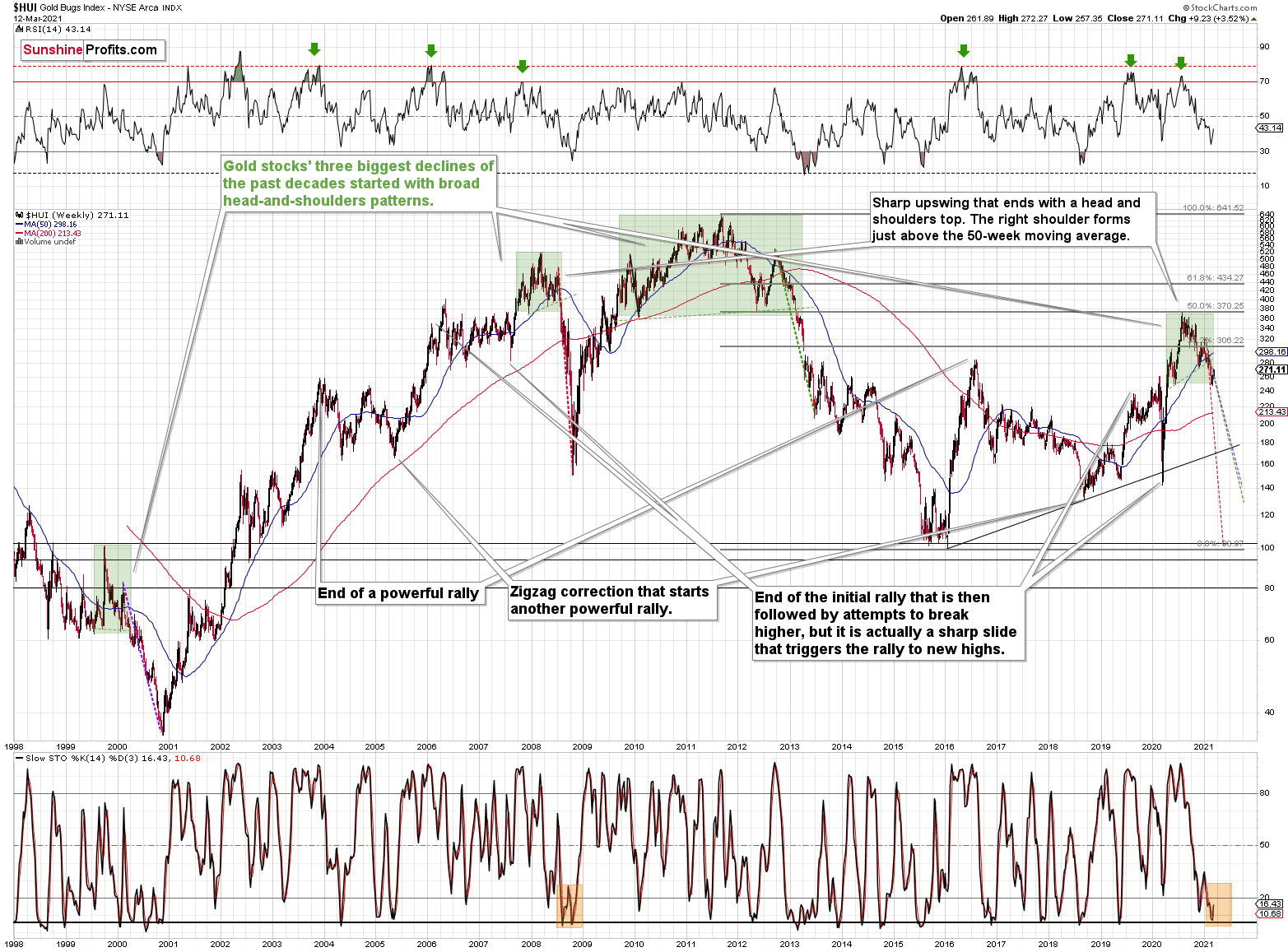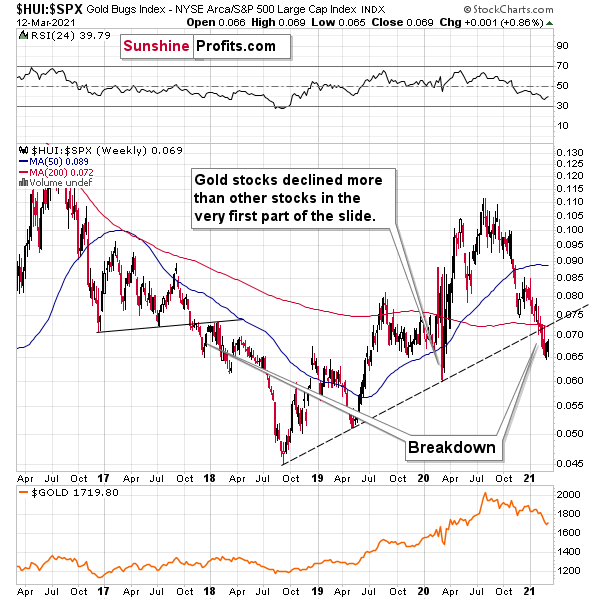Briefly: gold and the rest of the precious metals market are likely to decline in the next several weeks/months and then start another powerful rally. Gold’s strong bullish reversal/rally despite the USD Index’s continuous strength will likely be the signal that confirms that the bottom is in.
Welcome to this week's Gold Investment Update. Predicated on last week’s price moves, our most recently featured outlook remains the same as the price moves align with our expectations. On that account, there are parts of the previous analysis that didn’t change at all in the earlier days, which will be written in italics.
To begin, let’s discuss the fundamental news that hit the market last week, namely the European Central Bank’s (ECB) recent announcement related to the acceleration of its asset purchases and how, if the Fed doesn’t follow suit, gold may continue a bearish trend.
On Thursday (Mar. 11), the European Central Bank decided to accelerate its asset buying under the Pandemic Emergency Purchase Program:
Based on a joint assessment of financing conditions and the inflation outlook, the Governing Council expects purchases under the PEPP over the next quarter to be conducted at a significantly higher pace than during the first months of this year.
The decision came after a rise in the European bond yields that has mirrored a similar move in the U.S. Treasuries (see the chart below). Christine Lagarde, the ECB President, was afraid that increasing borrowing costs could hamper the economic recovery, so she decided to talk down the bond yields.
Indeed, the growth forecasts for the EU have deteriorated recently amid the persistence of the pandemic and painfully slow rollout of the vaccines. According to the ECB, the real GDP of the bloc is likely to contract again in the first quarter of the year. So, the increase in the market interest rates could additionally drag down the already fragile economic recovery:
Market interest rates have increased since the start of the year, which poses a risk to wider financing conditions. Banks use risk-free interest rates and sovereign bond yields as key references for determining credit conditions. If sizeable and persistent, increases in these market interest rates, when left unchecked, could translate into a premature tightening of financing conditions for all sectors of the economy. This is undesirable at a time when preserving favourable financing conditions still remains necessary to reduce uncertainty and bolster confidence, thereby underpinning economic activity and safeguarding medium-term price stability.
What does all this mean for gold prices? Well, the ECB’s move should prove rather negative for the price of gold, at least initially. This is because the loosening of the European monetary policy could weaken both the euro and gold against the U.S. dollar. Indeed, as the chart below shows, although the price of gold increased on Thursday, it declined one day later.
Moreover, the acceleration in the ECB’s quantitative easing could further widen the divergence in the interest rates (that started rising in the third quarter of 2020, as one can see in the chart below) between the U.S. and the EU, which should also support the greenback at the expense of the yellow metal.
On the other hand, the fact that the ECB has intervened in the markets – announcing acceleration in the pace of its asset buying program, after a certain rebound in the bond yields – could turn out to be positive for gold prices, at least in the long-run. This is because it shows how fragile the modern economies are and how dependent they have become on cheap borrowing guaranteed by the central banks.
As I noticed earlier in the past, we are in the debt trap – and the central banks will not allow for the true normalization of the interest rates. The latest ECB’s action is the best confirmation that suppression of the real interest rates will continue, thus supporting gold prices. After all, the ECB has effectively put a cap on bond yields, introducing an informal yield curve control.
So far, only the ECB has intervened in the markets, but other central banks could follow suit. This week, the Fed will announce its decision on the monetary policy. And we cannot exclude that the American central bank will also signal a more dovish stance to calm the turmoil in the bond markets and prevent further increases in the interest rates. One thing is certain: gold needs some fresh dovish hints from the Fed to go up. Unless the Fed further eases its stance, I’m afraid that gold will continue its bearish trend.
Having said that, let’s move to the cross-asset implications that could affect the precious metals in the coming weeks.
Over the medium-to-long-term, the copper/U.S. 10-Year Treasury yield ratio is a leading indicator of gold’s future behavior.
I wrote previously:
When the copper/U.S. 10-Year Treasury yield ratio is rising (meaning that copper prices are rising at a faster pace than the U.S. 10-Year Treasury yield), it usually results in higher gold prices. Conversely, when the copper/U.S. 10-Year Treasury yield ratio is falling (meaning that the U.S. 10-Year Treasury yield is rising at a faster pace than copper prices), it usually results in lower gold prices.
If you analyze the chart below, you can see the connection:
Peaking and rolling over within days of one another, the copper/U.S. 10-Year Treasury yield ratio declined by another 1.42% last week. But putting on a brave face, gold rallied by 1.25%.
However, despite the one-week divergence, if you analyze the monthly chart below, you can see that the yellow metal often follows in the former’s footsteps:
Even more revealing, with the U.S. 10-Year Treasury yield surging by more than76% year-to-date (YTD) and by more than 198% since its August trough, gold topped exactly one day after the U.S. 10-Year Treasury yield bottomed. Moreover, their divergence has continued ever since.
The bottom line?
With Treasury yields continuing their ascension, the yellow metal’s recent strength could be short-lived. With higher yields likely to pressure the copper/U.S. 10-Year Treasury yield ratio, 20+ years of history implies that short-term divergence – like the one that we witnessed last week – is unlikely to persist.
As another source of resistance, the USD Index continues to defy historical precedent. If you analyze the table below, you can see that a bottom and subsequent move higher in the U.S. 10-Year Treasury yield has coincided with a rise in the USD Index 80% of the time since 2003.
And while the USD Index is lower now than it was in August, the greenback is beginning to follow the U.S. 10-Year Treasury yield higher.
Moreover, given its strong negative correlation with the U.S. dollar, gold’s pain tends to coincide with U.S. dollar gains. As a result, if the USD Index continues its upward momentum, it will add even more concrete to gold’s wall of worry.
On the flip side, if we extend our time horizon, there are plenty of fundamental reasons why gold is likely to soar in the coming years. However, even the most profound bull markets don’t move up in a straight line, and corrections are inevitable.
As it relates to the precious metals, a significant correction (medium-term downtrend) is already underway. However, the pain is not over, and a severe climax likely awaits.
For context, potential triggers are not always noticeable, and the PMs may collapse on their own or as a result of some random trigger that normally wouldn’t cause any major action. However, a trigger will speed things up and that’s where the S&P 500 comes in:
S&P 500 (SPX) Signals
While the S&P 500 closed at a new all-time high on Mar. 12, beneath the surface, the situation isn’t so sanguine. Diverging from the underlying, S&P 500 E-Mini Futures retreated after hitting the upper trendline of its monthly channel.
Please see below:
To explain the significance, I wrote on Mar. 12:
S&P 500 futures didn’t move to a new high and they reversed after moving to the combination of resistance provided by the rising resistance line and the previous high. Consequently, we might have just seen a top in stocks, which would be the right shoulder of a medium-term head-and-shoulders pattern. The implications would be very bearish.
What’s more, while the S&P 500 index continues to hold its rising support line (the solid red line below), the index has broken below its dotted rising support line. Taken together, the divergence is medium-term bearish.
As a less reliable indicator, the SPDR Dow Jones Industrial Average ETF’s (DIA) Relative Strength Index (RSI) is also forming a potential triple top (similar to what we witnessed in 2019/2020). However, the pattern remains unverified and the prospect is more of an “if” than an inevitability.
But saving the best for last, the loss of NASDAQ leadership signals that U.S. equities’ mid-February top was likely real. Why so? Because with NASDAQ constituents propping up the S&P 500 for much of 2020, a significant drawdown of the former should weigh heavily on the latter.
Please see below:
As further evidence, the NASDAQ 100/Russell 2000 ratio is doing something unseen since November 2000.
On Mar. 2, I wrote:
The green line at the bottom of the chart above depicts the percentage change in the NASDAQ 100/Russell 2000 ratio. As you can see, only one other time in history has the NASDAQ 100/Russell 2000 ratio declined by 25% or more after hitting a 12-month high. For context, November 2000 was roughly 10 months before the NASDAQ Composite troughed (September 2001). And while timing is extremely difficult, it’s a matter of when, not if, equities suffer a similar fate.
Keep in mind though: a decline in stocks is not required for the PMs to decline. But a break in the former could easily trigger a sell-off in the latter, and if history decides to rhyme again, silver and the miners will be the hardest hit.
Goodbye 2020, Welcome 2021
With February’s monthly close the last piece of the puzzle, the MACD indicator’s sell-signal is now perfectly clear. If you analyze the chart below (at the bottom right), you can see that the MACD line has crossed the signal line from above – a development that preceded significant drawdowns in 2008 and 2011.
Based on gold’s previous performance after the major sell signals from the MACD indicator, one could now expect gold to bottom in the ~$1,200 to ~1,350 range. Given the price moves that we witnessed in 1988, 2008 and 2011, historical precedent implies gold forming a bottom in this range. However, due to the competing impact of several different variables, it’s possible that the yellow metal could receive the key support at a higher level.
For more context, I wrote previously:
Only a shade below the 2011 high, today’s MACD reading is still the second-highest reading in the last 40 years. More importantly though, if you analyze the chart below (the red arrows at the bottom), the last four times the black line cut through the red line from above, a significant drawdown occurred.
Also ominous is that the magnitude of the drawdowns in price tend to coincide with the magnitude of the preceding upswings in MACD. And with today’s reading only surpassed by 2011, a climactic move to the $1,250/$1,450 range isn’t out of the question for gold. The above is based on how low gold had previously declined after similarly important sell signal from the MACD
Now, the month is not over yet, so one might say that it’s too early to consider the sell signal that’s based on monthly closing prices, but it seems that given the level that the MACD had previously reached and the shape of the top in the black line, it makes the situation so similar to 2011/2012 that the sell signal itself is just a cherry on the bearish analytical cake.
Considering the reliability of the MACD indicator as a sell signal for major declines, the reading also implies that gold’s downtrend could last longer and be more severe than originally thought. As a result, $1,500 remains the most likely outcome, with $1,350 still in the cards.
The USD Index (USDX)
The price shape and time analogies are truly remarkable right now. It’s quite often the case that history rhymes, but it’s rare for it to rhyme so closely and clearly to what we now see in the case of the USD Index. And the implications for precious metals investors are profound.
On Mar. 8, I warned that with the USD Index confronting its mid-2020 lows (resistance), a short-term dip could occur in the coming days. But after declining by 0.34% last week, the negativity could be short lived.
Case in point: the 2017-2018 analogue is already in full swing, and while short-term dips were part of the historical journey, the USDX could be about to exit its consolidation phase.
Please see below:
You can also see the similarity between two periods and the technical patterns that they included in the chart below:
Even while looking at the price moves for just a second, the size and shape of the 2017-2018 analogue clearly mirrors the 2020-current price action. Although this time, it took less than 118 days for the USD Index to move from peak to trough.
In 2017-2018, it also took 82 days for the USDX to form a final bottom (the number of days between the initial bottom and the final bottom) and the duration amounts to 21.19% of the overall timeframe. If we applied a similar timeframe to today’s move, then the USD Index should have bottomed on Feb. 12. It actually bottomed (finally) on Feb. 25, which was just 8 trading days away from the former date. Taking into account the sizes of the moves that preceded the previous declines (they took approximately one year to complete), this is extremely close and an excellent confirmation that the self-similar pattern remains intact.
In addition, as the USDX approached its final bottom in 2017-2018, gold traded sideways. Today, however, gold has been in a downward spiral. From a medium-term perspective, the yellow metal’s behavior is actually more bearish than it was in 2017-2018.
Finally, the USD Index’s breakout above its 50-day moving average (which it still holds today) is exactly what added gasoline to the USDX’s 2018 fire. Case in point: after the 2018 breakout, the USDX surged back to its previous high. Today, that level is roughly 94.5.
Moreover, gold’s trepidation alongside the USD Index strength on Mar. 12 adds even more validity to the 2017-2018 analogy.
I wrote on Mar. 10:
It’s not true that there were no pullbacks during the 2018 rally. There were, but they were simply too small to be visible from the long-term point of view.
The first notable pullback took place in early May 2018, and it contributed to a corrective upswing in the precious metals market. To be precise, the USD Index declined after rallying for 56 trading days, but gold rallied earlier – 51 trading days after the USD Index’s final bottom. The USDX’s immediate-top formed 16 trading days after its final bottom, and gold’s bottom formed 10 trading days after the USD’s final bottom.
Comparing this to the size of the previous decline in terms of the trading days, it was:
- 51 – 56 trading days / 283 trading days = 18.02% - 19.79%
- 10 – 16 trading days / 283 trading days = 3.53% - 5.65%
More importantly though, when the USD Index turned a short-term decline into consolidation in mid-2018, gold’s hesitant reaction highlighted the yellow metal’s anxiety. And what followed? Well, gold’s next move was significantly lower, while the USD Index’s next move was significantly higher. This means that it was likely a good idea that we took profits from our long positions recently when the GDX moved to $32.96 (opening at $30.80 - $31).
Please see below:
In addition, if we analyze the pairs’ very recent price action, it’s a splitting image.
On Friday (Mar. 12), the USD Index rallied by 0.28%, while gold was (roughly) directionless despite the intraday volatility. And just like in 2017-2018, the yellow metal’s behavior signals a forthcoming climax. As a result, gold and the USD Index are behaving exactly as they did before going their separate ways in 2017-2018. And this means a bearish gold price prediction for the following weeks (not necessarily hours, though).
Please see below:
To explain, I wrote on Mar. 10:
Let’s examine the current situation: the preceding decline lasted for 200 trading days and there were 41 – 42 trading days between the final USDX bottom and the short-term reversals in gold and USDX. Comparing this to the final USDX bottom, we get 7 – 8 trading days.
Applying the previous percentages to the length of the most recent medium-term decline in the USD Index provides us with the following:
- 18.02% - 19.79% x 200 trading days = ~36 - ~40 trading days
- 3.53% - 5.65% x 200 trading days = ~7 - ~11 trading days
The above estimation of about 36 – 40 trading days almost perfectly fits the current 41 – 42-day delay, and the estimation of about 7 – 11 trading days almost perfectly fits the current delay of 7 – 8 trading days.
In other words, the analogy to the 2018 performance does not only remain intact – it actually perfectly confirms the validity of the current corrective upswing. Once again, it’s very likely just a pullback, not a big trend reversal.
The bottom line?
Given the size of the 2018 upswing, 94.5 on the USD Index is likely the first, of many, potential upside targets.
Adding to the list of upside catalysts, the USD Index still has plenty of other bullets in its chamber. For instance, we’re also in the early innings of a shift in U.S. dollar sentiment. With short interest hitting an all-time high in late-2020, it was a complete fire sale. Today, however, short interest may have peaked.
Please see the below chart based on the CoT report:
Please consider how big rallies followed the moments when the net speculative position as % of total open interest started to rally back up after being oversold for months. The situation here is still more extreme than it was in early 2018 and 2014, suggesting that the upcoming rally might be bigger than the ones that we saw then.
As further evidence, speculative futures traders (non-commercial) actually reduced their net-short positions by 1,216 contracts last week (the net of the two values in the red box below). As a result, the slightest shift in sentiment could lead the rest of the herd to follow.
Finally, let’s not forget that the USD Index is after a long-term, more-than-confirmed breakout. This means that the long-term trend for the U.S. dollar is up.
In conclusion, the USD Index is likely shifting from consolidation to ascension. With the size, scope and duration of the recent price action mirroring 2017-2018, it’s only a matter of time before the USD Index’s medium-term breakout gives way to a material breakthrough. What’s more, the USD Index is finally reacting to the rise in U.S. Treasury yields. Initially ignoring the late-2020 surge, a bottom, and subsequent rally in the U.S. 10-Year Treasury yield has lifted the USD Index 80% of the time since 2003. And with the relationship seemingly restored in 2021, the combination is profoundly bearish for the PMs, especially given today’s triangle-vertex-based reversal in gold.
Third, with the NASDAQ’s underperformance likely a precursor to a medium-term top, a revaluation of technology stocks isn’t happening without some fireworks. To that point, after declining by 0.50% last week, the NASDAQ 100/S&P 500 ratio has now broken below the dot-com bubble peak.
Please see below:
And given the USDX’s strong negative correlation with the NASDAQ 100, a reversion to the mean could propel the greenback back to its March highs. Moreover, following a short-term consolidation, the USDX could even exceed those prior highs.
As for the FED/ECB ratio, relative outprinting by the European Central Bank (ECB) remains of critical importance. Last week, the ratio increased by 0.16%, while the EUR/USD rallied by 0.29%. However, the ratio has declined by more than 16% since May.
Please see below:
Also foretelling a weaker euro, the ECB announced on Mar. 11 that its weekly PEPP purchases will now “be conducted at a significantly higher pace.”
As a result, with the ECB injecting more liquidity to support the floundering Eurozone economy, the FED/ECB ratio, and the EUR/USD, should continue their treks lower. More importantly though, because the EUR/USD accounts for nearly 58% of the movement of the USD Index, EUR/USD pain will be the USDX’s gain.
To that point, I wrote previously:
The top in the FED/ECB total assets ratio preceded the slide in the EUR/USD less than a decade ago and it seems to be preceding the next slide as well. If the USD Index was to repeat its 2014-2015 rally from the recent lows, it would rally to 114. This level is much more realistic than most market participants would agree on.
Sentiment Indicators
Remaining unchanged last week, the Gold Miners Bullish Percent Index ($BPGDM) is still below 25. However, far from a medium-term bottom, the latest reading is more than 15 points above the 2016 and 2020 lows.
On Dec. 14, I wrote:
Back in 2016 (after the top), and in March 2020, the buying opportunity didn’t present itself until the $BPGDM was below 10.
Thus, with sentiment still relatively elevated, it will take more negativity for the index to find a bottom.
For more context, I wrote previously:
The excessive bullishness was present at the 2016 top as well and it didn’t cause the situation to be any less bearish in reality. All markets periodically get ahead of themselves regardless of how bullish the long-term outlook really is. Then, they correct. If the upswing was significant, the correction is also quite often significant.
Please note that back in 2016, there was an additional quick upswing before the slide and this additional upswing had caused the $BPGDM to move up once again for a few days. It then declined once again. We saw something similar also in the middle of this year. In this case, the move up took the index once again to the 100 level, while in 2016 this wasn’t the case. But still, the similarity remains present.
Back in 2016, when we saw this phenomenon, it was already after the top, and right before the big decline.
Based on the decline from above 350 to below 280, we know that a significant decline is definitely taking place. But has it already run its course?
Let’s consider two similar cases when gold miners declined significantly after the $BPGDM was very high: the 2016 decline and early-2020 decline.
In both cases, the HUI Index continued to decline until it moved slightly below its 61.8% Fibonacci retracement level. This means that if the history is to repeat itself, we shouldn’t expect any major turnaround until the gold miners decline to 220 - 230 or so. Depending on how things are developing in gold, the above might or might not be the final bottom, though.
Please note that the HUI already declined below its 2016 high. This breakdown is yet another bearish sign.
The Gold Miners
After closing only $0.10 below my initial downside target of $31, I warned on Mar. 1 that the GDX ETF was ripe for a reversal:
I wrote:
The GDX ETF has garnered historical support at roughly $29.52. The level also coincides with the early-March high, the mid-April low and the 61.8% Fibonacci retracement level. As a result, a corrective upswing to ~$33/$34 could be the miners’ next move.
And after alerting subscribers on Mar. 4 that when gold moves to $1,692, we’ll automatically open long positions in the miners, we closed our long positions on Mar. 11 after recording a ~6% gain.
But with the easy money in the rearview and the medium-term outlook profoundly bearish, lower-for-longer remains the mantra confronting the miners.
On Mar. 12, I wrote:
The GDX ETF didn’t move to the strongest combination of nearby resistance levels, but it did flash a few bearish signs, anyway. The resistance that it reached was notable as it moved to its November 2020 low. Consequently, “it makes sense” for the mining stocks to have topped here.
Yes, miners were strong relative to gold yesterday, but it was practically the only thing that was positive about yesterday’s session and the USDX’s performance along with gold’s weakness seem more important.
The 2016 rally started with a fake breakdown and fake underperformance of gold. So, while the continuous underperformance of miners (compared to gold) is very often bearish, a single day of strength or weakness might be a trap.
As further evidence for the bearish case, the GDX ETF’s RSI ended the week at 50.14 – aligning perfectly with three short-term tops that occurred earlier this year (the red arrows below). And while the GDX ETF was able to buck the RSI trend in January, the combination of a resurgent USD Index and a forthcoming decline in gold signals that the miners have likely peaked.
What’s more, even if the GDX ETF does move slightly higher in the short-term, the shoe could drop at any moment. But how low could the GDX ETF go?
Our final downside target area ($15 – $24.5) is quite broad, because a lot depends on what the general stock market will do. I’ll be looking at gold for the key signs along with a few other factors (including the Gold Miners Bullish Percent Index) and determined the buying opportunity based on them – not necessarily based on the price of the GDX or GDXJ by itself.
Yes, this target is quite low, and thus might appear unrealistic, but let’s consider the following:
- Miners are slightly above their early-2020 high – just like gold.
- Gold is likely to decline to its 2020 lows or so
- General stock market might have just topped.
Considering all three above factors it’s clear that a move to even the 2020 lows is not out of the question.
And this means that junior miners might decline more than senior miners. A move from the current levels to the 2020 would imply a decline by about 50% in case of the GDX, and by about 60% in case of the GDXJ.
Headlining the potential move, the GDX ETF’s head and shoulders pattern – marked by the shaded green boxes above – could be the canary in the coal mine.
I wrote previously:
Ever since the mid-September breakdown below the 50-day moving average, the GDX ETF was unable to trigger a substantial and lasting move above this MA. The times when the GDX was able to move above it were also the times when the biggest short-term declines started.
(…)
The most recent move higher only made the similarity of this shoulder portion of the bearish head-and-shoulders pattern to the left shoulder) bigger. This means that when the GDX breaks below the neck level of the pattern in a decisive way, the implications are likely to be extremely bearish for the next several weeks or months.
Turning to the junior gold miners, the GDXJ ETF will likely be the worst performer during the upcoming swoon. Why so? Well, due to its strong correlation with the S&P 500, a swift correction of U.S. equities will likely sink the juniors in the process.
What’s more, unreliable signals from the MACD indicator epitomizes the GDXJ ETF’s heightened volatility.
Please see below:
To explain, I wrote on Mar. 12:
The above chart is a big red warning flag for beginner investors. The flag reads: “verify the efficiency of a given tool on a given market, before applying it”.
The bottom part of the above chart features the MACD indicator. Normally, when the indicator line (black) crosses its signal line (red), we have a signal. If it’s moves above the signal line, it’s a buy sign, and if it moves below it, it’s a sell sign.
But.
If one actually looks at what happened after the previous “buy signals” in the recent months, they will see that in 5 out of 6 cases, these “buy signals” practically marked the exact tops, thus being very effective sell signals! In the remaining case, it was a good indication that the easy part of the corrective upswing was over.
I’m not only describing the above due to its educational value, but because we actually saw a “buy signal” from the MACD, which was quite likely really a sell signal.
But how low could the GDXJ ETF go?
As it is the case with the GDX, a lot depends on the general stock market and our final target area is quite broad (between $18 and $26), and the key indications will come from other markets and the way they behave relative to each other.
There’s an interim (and strong) support provided by the $42.5 level, which might trigger a corrective upswing, but since we have just seen one, it’s far from being certain that we’ll see another corrective upswing so soon. This could be another opportunity to profit on a long position in the gold miners, but we can’t say that we’ll definitely go long at that time – at least not based on the information that we have available right now. Naturally, we’ll keep monitoring the situation and send out regular (and intraday) Alerts with details as more information becomes available.
Let’s keep in mind that in mid-2020, the GDX ETF invalidated its long-term breakout above the 61.8% Fibonacci retracement level (based on the 2011 to 2016 decline).
Please see below:
To explain, I wrote previously:
When GDX approached its 38.2% Fibonacci retracement, it declined sharply – it was right after the 2016 top. And miners’ inability to move above the 61.8% Fibonacci retracement level and their invalidation of the tiny breakout is a bearish sign. The same goes for miners’ inability to stay above the rising support line – the line that’s parallel to the line based on the 2016 and 2020 lows.
In addition, let’s keep in mind that the similarity to how miners declined in 2013 also remains intact and the red ellipses marked on the above chart show that a short-term pause is a normal part of even the biggest declines. Consequently, the recent corrective upswing doesn’t have to mean much, if anything, from the medium-term point of view.
Highlighting the significance of the NASDAQ 100/S&P 500 ratio, an unwinding of NASDAQ speculation could deliver a fierce blow to the gold miners. Back in 2000, when the dot-com bubble burst, the NASDAQ lost nearly 80% of its value, while gold miners lost more than 50% of their value.
Please see below:
To explain, I wrote previously:
Right now, the two long-term channels above (the solid blue and red dashed lines) show that the NASDAQ is trading well above both historical trends.
Back in 1998, the NASDAQ’s last hurrah occurred after the index declined to its 200-day moving average (which was also slightly above the upper border of the rising trend channel marked with red dashed lines).
And what happened in the first half of 2020? Well, we saw an identical formation.
The similarity between these two periods is also evident if one looks at the MACD indicator. There has been no other, even remotely similar, situation where this indicator would soar so high.
Furthermore, and because the devil is in the details, the gold miners’ 1999 top actually preceded the 2000 NASDAQ bubble bursting. It’s clear that miners (the XAU Index serves as a proxy) are on the left side of the dashed vertical line, while the tech stock top is on its right side. However, it’s important to note that it was stocks’ slide that exacerbated miners’ decline. Right now, the mining stocks are already declining, and the tech stocks continue to rally. Two decades ago, tech stocks topped about 6 months after miners. This might spoil the party of the tech stock bulls, but miners topped about 6 months ago…
Also supporting the 2000 analogue, today’s volume trends are eerily similar. If you analyze the red arrows on the chart above, you can see that the abnormal spike in the MACD indicator coincided with an abnormal spike in volume. Thus, mounting pressure implies a cataclysmic reversal could be forthcoming.
Interestingly, two decades ago, miners bottomed more or less when the NASDAQ declined to its previous lows, created by the very first slide. We have yet to see the “first slide” this time. But, if the history continues to repeat itself and tech stocks decline sharply and then correct some of the decline, when they finally move lower once again, we might see THE bottom in the mining stocks. Of course, betting on the above scenario based on the XAU-NASDAQ link alone would not be reasonable, but if other factors also confirm this indication, this could really take place.
Either way, the above does a great job at illustrating the kind of link between the general stock market and the precious metals market that I expect to see also this time. PMs and miners declined during the first part of the stocks’ (here: tech stocks) decline, but then they bottomed and rallied despite the continuation of stocks’ freefall.
Gold
After warning on Mar. 8 that a short-term corrective upswing could be the next chapter in the yellow metal’s book, gold proceeded to rally by 1.25% last week.
Please see below:
But with short-term strength likely to give way to medium-term weakness, in 2020, five bullish advances were rejected at the 50% Fibonacci retracement level. And with a USD Index uprising likely on deck, the mosaic signals that the yellow metal may have already peaked.
Please see below:
Destined for devaluation after hitting its triangle-vertex-based reversal point (which I warned about previously; currently marked in blue), gold has been stuck in reverse ever since. And since the yellow metal is scheduled to collide with another triangle-vertex-based reversal point on Mar. 15, any intraday strength is likely to elicit a ‘sell the rally’ response – either immediately or shortly. As a result, ~$1,770 is where the best-case (for bulls that is) scenario likely ends, as the 50% Fibonacci retracement level should deliver another rejection.
Remember though: even if gold does rally back to ~$1,770, it does not change the medium-term outlook. Why? Because if the S&P 500 did indeed peak in February, the PMs will likely suffer for three-and-a-half months from that date (to mid or late-May).
There is a good chance, however, that gold has already topped in overnight trading.
The corrective upswing that we saw after the January decline, took gold above the 38.2% Fibonacci retracement level twice, and that was when gold topped. The same thing happened just several hours ago. Let’s keep in mind that the triangle-vertex-based reversal technique doesn’t necessarily point one to the ultimate top or bottom, but rather to “some kind of top or bottom”. It’s often the key one, but it’s not necessarily the case. So, could the overnight action be the top that the triangle-vertex-based reversal technique had been pointing to? Absolutely yes.
Let’s zoom out, not to miss the forest for the trees. From a long-term perspective, the yellow metal has already invalidated the breakout above its 2011 high, which has profoundly bearish implications.
Please see below:
Furthermore, if the 2008 analogue repeats – and a stock-market swoon enters the equation – the PMs could move substantially lower. When combining an equity shock with a USD Index resurgence, the yellow metal could bottom at roughly $1,400 (or even ~$1,350). However, $1,450 remains to be the most likely downside target, as it coincides with the 61.8% Fibonacci retracement level and the 2019 and 2020 lows.
For more context, I wrote previously:
If you analyze the red arrow in the lower part of the above chart (the weekly MACD sell signal), today’s pattern is similar not only to what we saw in 2011, but also to what we witnessed in 2008. Thus, if similar events unfold – with the S&P 500 falling and the USD Index rising (both seem likely for the following months, even if these moves don’t start right away) – the yellow metal could plunge to below $1,350 or so. The green dashed line shows what would happen gold price, if it was not decline as much as it did in 2008.
As it relates to the chart below, relative to 2011-2013, today’s price action is a splitting image. For starters, gold invalidated the breakout above its 2011 highs. Invalidations of breakouts are sell signals, and it’s tough to imagine a more profound breakout that could have failed.
Second, if you analyze the two white boxes (on the left side of the chart), the blue lines depict today’s short-term price action relative to 2013. As you can see, the movement is nearly identical. I copied the price performance twice, so that you can more easily see the similarity in terms of both the price and time.
Please note that gold delivered a final corrective rebound from the previous lows (so called dead cat bounce) before suffering its current weakness. And in 2013, the yellow metal did the exact same thing. As a result, the free-fall phase has already begun, and the medium-term trend remains down.
For more context, I wrote previously:
The odd thing about the above chart is that I copied the most recent movement in gold and pasted it above gold’s 2011 – 2013 performance. But – admit it – at first glance, it was clear to you that both price moves were very similar.
And that’s exactly my point. The history tends to rhyme and that’s one of the foundations of the technical analysis in general. Retracements, indicators, cycles, and other techniques are used based on this very foundation – they are just different ways to approach the recurring nature of events.
However, every now and then, the history repeats itself to a much greater degree than is normally the case. In extremely rare cases, we get a direct 1:1 similarity, but in some (still rare, but not as extremely rare) cases we get a similarity where the price is moving proportionately to how it moved previously. That’s called a market’s self-similarity or the fractal nature of the markets. But after taking a brief look at the chart, you probably instinctively knew that since the price moves are so similar this time, then the follow-up action is also likely to be quite similar.
In other words, if something looks like a duck, and quacks like a duck, it’s probably a duck. And it’s likely to do what ducks do.
What did gold do back in 2013 at the end of the self-similar pattern? Saying that it declined is true, but it doesn’t give the full picture - just like saying that the U.S. public debt is not small. Back then, gold truly plunged. And before it plunged, it moved lower in a rather steady manner, with periodic corrections. That’s exactly what we see right now.
Please note that the above chart shows gold’s very long-term turning points (vertical lines) and we see that gold topped a bit after it (not much off given their long-term nature). Based on how gold performed after previous long-term turning points (marked with purple, dashed lines), it seems that a decline to even $1,600 would not be out of ordinary.
Finally, please note the strong sell signal from the MACD indicator in the bottom part of the chart. The only other time when this indicator flashed a sell signal while being so overbought was at the 2011 top. The second most-similar case is the 2008 top.
The above-mentioned self-similarity covers the analogy to the 2011 top, but what about the 2008 performance?
If we take a look at how big the final 2008 decline was, we notice that if gold repeated it (percentage-wise), it would decline to about $1,450. Interestingly, this would mean that gold would move to the 61.8% Fibonacci retracement level based on the entire 2015 – 2020 rally. This is so interesting, because that’s the Fibonacci retracement level that (approximately) ended the 2013 decline.
History tends to rhyme, so perhaps gold is going to decline even more than the simple analogy to the previous turning points indicates. For now, this is relatively unclear, and my target area for gold’s final bottom is quite broad.
Silver
On Feb. 16, I warned that two triangle-vertex-based reversal points could lead to fireworks by the end of February or early March.
Why? Because when we previously saw such sudden spikes in the silver inflows (proxy for the investment demand) it was precisely when silver topped. You can see the same phenomenon in case of volume.
In addition, after declining by more than 7% over that stretch, I warned on Mar. 8 that it was time to flip the script. I wrote:
With short-term capitulation likely to give way to a corrective upswing, silver’s recent depression likely marks a short-term bottom. Specifically, silver’s price action from August until now mirrors what we witnessed from August 2019 until March 2020. Repeating the pattern, last week’s negativity should elicit a corrective upswing.
And proving quite prescient, silver proceeded to bounce by more than 3.50% and the white metal ended the week up by 2.47%.
Please see below:
However, with the easy money also in the rearview, silver is repeating a pattern that we witnessed in March 2020. If you analyze the shaded rectangle on the left side of the chart below, you can see that silver declined substantially, delivered a short-term corrective upswing and then collapsed.
Luring in unsuspecting bulls by overshooting resistance levels and creating “fakeouts” (instead of breakouts) right before plunging, silver is extremely volatile. As a result, mainstream indicators are often misleading in the case of silver.
Remember, in March 2020, silver rallied to correct roughly half of its downswing and the white metal topped close to its 20-day moving average (marked with red) and the previous lows.
As of the Mar. 12 close, Silver’s 20-day moving average is currently at $26.72, and the mid-February lows are between $26.75 and $27.33 (I’m not counting the February 19 low, which seems relatively accidental). The 50% retracements are at $27.60 (if we take the 2021 high as the start of the decline) and $26.64 (if we use late-February top as the start of the decline). Based on the above levels, it seems that silver’s next short-term top is likely to form in the $26.60 - $26.85 range.
But would I wait until the above area is reached?
No, I’d prefer to focus on gold here, because it’s upside targets and indications are usually more reliable. And because gold is more predictable, when the yellow metal declines, silver often follows suit. Conversely, if gold’s triangle-vertex-based reversal point leads to an intraday rally on Mar. 15, silver might outperform. However, positioning for such an event offers more risk than reward. Silver didn’t outperform gold in the overnight trading (at least at the moment of writing these words), but it might still show some strength before the end of the session.
For the same reasons, silver’s affliction with volatility makes forecasting a downside target extremely difficult. Silver is likely to move lower less intensely in the initial stage, but catch up big-time in the final part of the decline – just as it did in 2020. Logically, if gold retests its 2020 lows (and the general stock market slides), silver could respond in kind – with ~$12 being a prospective target. However, as mentioned, following gold’s lead is a more prudent strategy.
As for the SLV ETF, its volume spikes in 2020/2021 were nearly identical to the surges that we witnessed ~10 years ago. If you analyze the chart below, you can see that the massive inflows at the end of 2012 were not the beginning of a medium-term upswing. In fact, they coincided with silver’s final bounce before the white metal suffered a major decline.
Please see below:
To explain, I wrote previously:
If you analyze the volume spikes at the bottom of the chart, 2021 and 2011 are a splitting image. To explain, in 2011, an initial abnormal spike in volume was followed by a second parabolic surge. However, not long after, silver’s bear market began.
SLV-volume-wise, there's only one similar situation from the past - the 2011 top. This is a very bearish analogy as higher prices of the white metal were not seen since that time, but the analogy gets even more bearish. The reason is the "initial warning" volume spike in this ETF. It took place a few months before SLV formed its final top, and we saw the same thing also a few months ago, when silver formed its initial 2020 top.
The history may not repeat itself to the letter, but it tends to be quite similar. And the more two situations are alike, the more likely it is for the follow-up action to be similar as well. And in this case, the implications for the silver price forecast are clearly bearish.
Based on the above chart, it seems that silver is likely to move well above its 2011 highs, but it’s unlikely to do it without another sizable downswing first.
Similarly, silver’s inverse price action also has bearish implications. Nearly identical to the inverted formation that emerged from 2006 to 2009, today’s chart looks eerily similar to its predecessor.
I wrote previously:
While it’s more of a wild card, the above pattern shows that silver’s 2020 top plots nearly identical to the inverse of the 2006-2009 performance. I copied the 2006 – 2009 performance right below the regular price movement and I inverted it, and I also copied this inverted pattern to the last few years.
The similarity is quite significant. And whenever a given pattern has been repeated, the odds are that it could also repeat in the not-too-distant future. Of course, there is no guarantee for that, but once the same market has reacted in a certain way to a specific greed/fear combination, it can just as well do it again. And these similarity-based techniques work quite often. So, while it’s not strong enough to be viewed as a price-path-discovery technique on its own, it should make one consider some scenarios more closely. In particular, this means that the declines in the prices of silver, gold, and mining stocks could be bigger and take longer than it seems based on other charts and techniques.
The above is also in tune with the implications of the sell signal from the MACD indicator on the monthly gold chart.
The only thing that comes to my mind, which could – realistically – trigger such a prolonged decline would be a major drop in the general stock market. Given what I wrote above, the latter is quite possible, so I’ll be on the lookout for confirmations and invalidations of this scenario.
If history rhymes, silver could be in for a profound decline over the next few months (beyond my initial target). Moreover, the development would increase the duration of a precious metals’ bear market (also beyond my initial forecast).
After all, gold did invalidate its long-term breakout above the 2011 highs and the way gold reacted to a small upswing in the USD Index was truly profound…
Moving on to the HUI Index (a proxy for gold stocks), it’s also flashing red in a very bright way – especially from a medium-term perspective.
I wrote previously:
The three of the biggest declines in the mining stocks (I’m using the HUI Index as a proxy here), all started with broad, multi-month head-and-shoulders patterns. And now we’re seeing this pattern all over again.
The above picture should make it clear why I was putting “at least” in bold, when describing the targets based on the head-and-shoulders patterns.
In all three cases, the size of the decline exceeded the size of the head of the pattern. This means that the $24 target on the GDX ETF chart is likely conservative.
Can we see gold stocks as low as we saw them last year? Yes.
Can we see gold stocks even lower than at their 2020 lows? Again, yes.
Of course, it’s far from being a sure bet, but the above chart shows that it’s not irrational to expect these kind of price levels before the final bottom is reached.
The dashed lines starting at the 2020 top are copies of sizes of the declines that started from the right shoulder of the previous patterns. If things develop as they did in 2000 and 2012-2013, gold stocks are likely to bottom close to their 2020 high. However, if they develop like in 2008 (which might be the case, given the extremely high participation of the investment public in the stock market and other markets), gold stocks could re-test (or break slightly below) their 2016 low.
I know, I know, this seems too unreal to be true… But wasn’t the same said about silver moving below its 2015 bottom in 2020? And yet, it happened.
While describing gold’s very long-term chart, I wrote that based on gold’s MACD indicator, the situation is also similar to what happened in 2008. The above chart shows some additional similarities. Let’s consider the sizes of moves between the 2004 bottom (one could argue that this is when the several-year-long rally started) and the 2008 top, between the initial 2006 top and the 2008 top, and between the very beginning of the final rally – at the end of the fake sharp downswing and the 2008 top.
I marked all of them with dashed lines and I copied them to the current situation. By “current” I mean what happened recently and in the previous years – to the situations that seemed analogous to the ones described above. For instance, the near-vertical 2020 downswing that was followed by a big rally that ended with a big head-and-shoulders top seems similar to what happened in mid-2007.
As one might expect, these dashed lines don’t point to the same price top. No wonder – the history doesn’t repeat itself to the letter, as the circumstances are not identical.
But…
What is remarkable is that on average, these dashed lines did a great job at approximately (!) pinpointing the end of the entire rally and the start of the next massive move lower. One of these three dashed lines is several months too early, one is several months too late, and one is almost exactly pointing to the 2020 top.
This makes the current situation even more similar to what happened in 2008, which has profoundly bearish implications for the entire precious metals sector. I provided more details of this analogy in the Feb. 17 Gold & Silver Trading Alert (please be sure to read the part about similarities to 2008 in the HUI Index, if you haven’t done so already).
And continuing to rhyme, the gold miners are still following the 2008 analogue (even more than the 2013 analogue). If you analyze the dotted red line above (on the right side of the chart), it shows just how quickly the miners could decline should the 2008 analogue play out in full.
In addition, if you analyze the bottom area, you can see that in 2008, the stochastic oscillator initially rallied, before reversing and making a final bottom (marked with orange rectangle). Today, the reading is eerily similar. After delivering an initial bounce, last week’s negativity pushed the indicator back down again. However, to fully align with 2008, there is still plenty of room to move lower. There are likely to be very brief corrections along the way, just like there were corrections during the 2008 slide, but overall, it seems that the mining stocks are headed much lower and the buy signal from the stochastic indicator should be viewed as very short-term phenomena only.
As for the role of equities, I wrote previously:
A move of this magnitude most likely requires equities to participate. In 2008 and 2020, the sharp drawdowns in the HUI Index coincided with significant drawdowns of the S&P 500. However, with the words ‘all-time high’ becoming commonplace across U.S. equities, the likelihood of a three-peat remains relatively high.
As further evidence, the HUI Index/S&P 500 ratio has broken below critical support.
Please see below:
To explain, when the line above is rising, it means that the HUI Index is outperforming the S&P 500. When the line above is falling, it means that the S&P 500 is outperforming the HUI Index. If you analyze the right side of the chart, you can see that the ratio has broken below its rising support line. For context, the last time a breakdown of this magnitude occurred, the ratio plunged from late-2017 to late-2018. Thus, the development is profoundly bearish.
Conversely, I wrote on Mar. 8 that the HUI Index likely outperforms the S&P 500 this week. And with the ratio bouncing off of the 0.065 level (the scale on the right side of the chart), the miners delivered. However, I also emphasized that a potential rally should be viewed as short-term bullish and medium-term bearish.
Why so?
Well, despite the 2016-2017 analogue signaling a move back to the original breakdown level (roughly 0.0725), the HUI Index’s outperformance of the S&P 500 has likely run its course. With a rising USD Index likely to pressure the PMs, the miners are unlikely to rally unilaterally. As a result, a decline in the HUI Index/S&P 500 ratio remains the path of least resistance.
But with all of that said: how will we know when a medium-term buying opportunity presents itself?
We view price target levels as guidelines and the same goes for the Gold Miners Bullish Percent Index (below 10), but the final confirmation will likely be gold’s strength against the ongoing USDX rally. At many vital bottoms in gold, that’s exactly what happened, including the March bottom.
Turning to cross-asset correlations, gold and silver’s 10-day correlations have stabilized for a second-straight week. Exhibiting a positive relationship with the S&P 500 and a negative relationship with the U.S. dollar, their behavior is akin to what we see over a 250-day period (a reliable length of time). Conversely, over the last 10 days, the miners have exhibited positive relationships with both the U.S. dollar and the S&P 500. However, given the miners’ tendency to follow gold’s lead – as well as exhibiting a negative correlation with the U.S. dollar over a 250-day period – a potential USD Index uprising is extremely bearish for the PMs.
For additional context, I wrote previously:
Since gold, silver, and mining stocks have been strongly negatively correlated with the USD Index in the medium term, it seems likely that they will be negatively affected by the upcoming sizable USDX upswing.
…Until we see the day where gold reverses or soars despite the U.S. currency’s rally.
If that happens with gold at about $1,700, we’ll have a very good chance that this was the final bottom. If it doesn’t happen at that time, or gold continues to slide despite USD’s pause or decline, we’ll know that gold has further to fall.
Naturally we’ll keep you – our subscribers – informed.
To move forward, how does the GDX downside target compare to gold’s downside target? If, at the same time, gold moves to about $1,700 and miners are already after a ridiculously big drop (to $31-$32 in the GDX ETF, or lower), the binding profit-take exit price of your GDX ETF will become $32.02 (those with higher risk tolerance might lower it to $31.15 or so, but moving it lower seems just too risky).
At this time, the final GDX target (the one that would correspond to gold at $1,500 or so) is still unclear. The $17 - $23 area seems probable, especially if the general stock market slides once again. It’s too early to say with any significant level of certainty. Gold is providing us with a clearer final target, so that’s what we’ll focus on. And most importantly – we’ll focus on gold’s performance relative to the USD Index.
Overview of the Upcoming Part of the Decline
- It seems to me that we are already after the initial bottom and the initial correction. If not, then it seems likely to me that the corrective upswing will be completed within a week. It’s more likely that the next big move lower is already underway, though.
- After miners slide once again in a meaningful and volatile way, but silver doesn’t (and it just declines moderately), I plan to switch from short positions in miners to short positions in silver (this could take another 1-2 weeks to materialize). I plan to exit those short positions when gold shows substantial strength relative to the USD Index, while the latter is still rallying. This might take place with gold close to $1,450 - $1,500 and the entire decline (from above $1,700 to about $1,475) would be likely to take place within 1-12 weeks and I would expect silver to fall hardest in the final part of the move. This moment (when gold performs very strongly against the rallying USD and miners are strong relative to gold – after gold has already declined substantially) is likely to be the best entry point for long-term investments in my view. This might happen with gold close to $1,475, but it’s too early to say with certainty at this time. In other words, the entire decline could take between 1 and 12 weeks, while silver declines particularly fast in the final 1-2 weeks.
- If gold declines even below $1,500 (say, to ~$1350 or so), then it could take another 10 weeks or so for it to bottom, but this is not what I view as a very likely outcome.
- As a confirmation for the above, I will use the (upcoming or perhaps we have already seen it?) top in the general stock market as the starting point for the three-month countdown. The reason is that after the 1929 top, gold miners declined for about three months after the general stock market started to slide. We also saw some confirmations of this theory based on the analogy to 2008. All in all, the precious metals sector would be likely to bottom about three months after the general stock market tops . If the mid-February 2020 top was the final medium-term top, then it seems that we might expect the precious metals sector to bottom in mid-May or close to May’s end.
- The above is based on the information available today and it might change in the following days/weeks.
Letters to the Editor
Q: Do you think the WINTER part of the Kondratiev cycle will take place in 2021, or at a later date?
A: I think that it will start in 2021. In fact, it might have already started.
Q: I was just about to join your Gold service, when I noticed the option to receive ALL trading advice, stocks, oil, etc. But I am confused by something. At the moment, PR seems to think that we may possibly have seen the top in U.S. stocks, and even if not, that a top is not far away (correct me if I have misinterpreted his advice).
But when I look at your stock advice section, Matthew Levy seems to be of the opposite opinion.
How is this intra-company variance possible – your senior (PR) adviser giving out (what I interpret to be) advice that contrasts with another member of your team?
I will definitely join the Gold service, but I'd just like to understand the nature of the other advice before deciding if I want access to it or not.
Many thanks
A: Thank you for the question – this is an important subject to explain. Before replying more precisely, I would like to stress that we don’t provide investment advice, only our general opinions on the markets.
Having said that, I would like to stress that I’m not imposing my views about any market to any other analyst that is providing their analyses on SunshineProfits.com, nor am I consulting my analyses (and require approval) from other analysts. To be 100% clear, every now and then, we’re discussing some issues with each other, but with mutual respect, we then describe the situation exactly as each of us sees it, which may or may not be in tune what others think.
This means that at times two people providing analyses might have opposing views on the same market.
For now, there is only one person specializing in directional trades in the case of any single market, but this will not be the case in the future – there will be more authors for a single market that might have different views, different strategies, different philosophies and approaches. This is not a “bug” but a “feature”. If everything was “set” by one person (for example, by me), there would be little-to-no benefit from having access to the thoughts and views offered by other authors, as there would be no real additional value from reading the same views.
Besides, based on my knowledge and market research, people usually want to read diverse opinions on the internet before making up their mind about something. Therefore, that’s exactly what we want to provide them with through our service. Why can’t people get diverse opinions without having to leave the platform?
I’m not afraid that my views get challenged, as it’s not my goal to prove that I’m always going to be correct (which is obviously not possible), nor am I interested in “flexing” power. My goal is to provide the best service to people who join our platform. I think the way to achieve this is through allowing authors to be independent and true to their views.
What I do mind is that the points taken in analyses be well researched, that the analyses are professional, ethical, and are created with great care regarding readers. Moreover, the authors need to adhere to my and this company’s WHY, which is: “to discover and share knowledge with people, so that they can improve their lives”. The analyses can’t be used to promote personal agendas or try to indoctrinate people with regards to an author’s political (or other) views (in fact, there was even a case where an author was forbidden to publish their analyses with us due to this very reason). The analysts are also forbidden to take any remuneration from any companies or ETFs that they might describe in their analyses in order to avoid both real and potential conflicts of interest. However, having opposite views to other authors on the platform is not and will not be forbidden, even if one would have opinions about the market that oppose the ones of the Editor-in-chief. I – PR – will be carefully reviewing the work, approach, and professional background of those that want to join our platform.
Also, Matthew Levy, CFA spotted many profitable trades in the specific (sector-based, including emerging markets) ETFs, which I wasn’t paying attention to, as that’s not my specialty (the precious metals sector is). If you’re considering broadening the scope of available services, and you’re interested in the stock market, I suggest that you give Matthew Levy’s Stock Trading Alerts a try.
Q: Is the exit price of JDST correctly stated at $39.87? That would mean the end exit level would be $24 for GDXJ - Correct ?
A: Yes, that’s the correct profit-take level for the JDST. It’s far from the current price as it’s based on a big projected move. It’s also based on the projection that this move would take between 10 and 50 trading days (actually, the longer it would take while the miners would fall each day, the higher the target would become; that’s due to the fact that GDXD and JDST multiply DAILY price moves, not the entire medium-term move).
I will update the target levels once we get closer to them – it will be then, when I’ll be able to make more precise projections.
I would like to stress that we might exit the short position before this target is reached, especially if miners decline profoundly, but silver doesn’t (we would then likely switch to silver).
Q: Please confirm if the
binding profit-take level for the GDXD is at $94.87?
A: Yes, that’s the correct profit-take level for the GDXD. It’s far from the current price as it’s based on a big projected move. It’s also based on the projection that this move would take between 10 and 50 trading days (actually, the longer it would take while the miners would fall each day, the higher the target would become; that’s due to the fact that GDXD and JDST multiply DAILY price moves, not the entire medium-term move).
I will update the target levels once we get closer to them – it will be then, when I’ll be able to make more precise projections.
I would like to stress that we might exit the short position before this target is reached, especially if miners decline profoundly, but silver doesn’t (we would then likely switch to silver).
Q: A cautionary tale. Yesterday, after receiving my second vaccine shot, I decided to take a nap. When I awoke, I saw the sell alert you posted earlier. I immediately sold everything but could not sell GDXU as it does not have extended hours trading. So, I put in a day sell order which was executed first thing this morning. But overnight I lost about $1.50 per share as gold had dropped $20! The same applies to GDXD.
I truly enjoy reading your daily analysis! But since I am not permitted to sell something I do not own on my trading platform, how do you suggest I short GDXJ?
A: I put the above warning in bold – it’s indeed very important. I previously wrote that the 3x leveraged instruments like GDXD and GDXU are for advanced traders only. In fact, most people would be fine with an unleveraged GDXJ trade (shorting it) instead of using leveraged instruments.
Also, please note that, in my view, the profits on this short trade are likely to be many times bigger than the profits on the recent long term (of course, I can’t promise any kind of performance, as it doesn’t depend on me).
This might sound silly on my part, but if you are not permitted to sell something you do not own on your trading platform, and you’d like to do it anyway, then you might want to consider moving to a different trading platform. Of course, other factors are important as well.
If you’re seeking leverage, then perhaps the JDST would be a useful vehicle for you. If you don’t want leverage and can only go long, then it’s more difficult, as I don’t think there are any unleveraged and inverse mining stock ETFs, at least there are no popular ones (if anyone knows one, please let us know, we’ll be happy to verify it), but if this is of key importance to you, you might consider the SBUL (WisdomTree Gold 1x Daily Short). It’s an inverse gold product, not one based on gold mining stocks, though.
Another idea would be to use (buy) put options for the GDXJ (with a relatively long time to expiration - at least several months) but use only a small amount of capital for it.
Summary
To summarize, the PMs’ medium-term decline is well underway, and based on the recent performance of the USD Index, general stock market and gold’s relative weakness vs. the USDX (along with a few other indications from mining stocks) it seems that the corrective upswing is already over (or about to be over). The next big move lower seems to be already underway.
In addition, because we’re likely entering the “winter” part of the Kondratiev cycle (just like in 1929 and then the 1930s), the outlook for the precious metals’ sector remains particularly bearish during the very first part of the cycle, when cash is king.
The confirmed breakout in the USD Index is yet another confirmation of the bearish outlook for the precious metals market.
After the sell-off (that takes gold to about $1,450 - $1,500), we expect the precious metals to rally significantly. The final part of the decline might take as little as 1-5 weeks, so it's important to stay alert to any changes.
Most importantly, please stay healthy and safe. We made a lot of money last March and it seems that we’re about to make much more on this March decline, but you have to be healthy to enjoy the results.
As always, we'll keep you - our subscribers - informed.
By the way, we are opening a possibility to extend one's subscription for a year, two years or even three years with a special 20% discount. This discount can be applied right away, without the need to wait for your next renewal – if you choose to secure your premium access and complete the payment upfront. The boring time in the PMs is definitely over and the time to pay close attention to the market is here. Naturally, it’s your capital, and the choice is up to you, but it seems that it might be a good idea to secure more premium access now, while saving 20% at the same time. Our support team will be happy to assist you in the above-described upgrade at preferential terms – if you’d like to proceed, please contact us..
To summarize:
Short-term outlook for the precious metals sector (our opinion on the next 1-6 weeks): Bearish
Medium-term outlook for the precious metals sector (our opinion for the period between 1.5 and 6 months): Bearish initially, then possibly Bullish
Long-term outlook for the precious metals sector (our opinion for the period between 6 and 24 months from now): Bullish
Very long-term outlook for the precious metals sector (our opinion for the period starting 2 years from now): Bullish
As a reminder, Gold Investment Updates are posted approximately once per week. We are usually posting them on Monday, but we can’t promise that it will be the case each week.
Our preferred ways to invest in and to trade gold along with the reasoning can be found in the how to buy gold section. Additionally, our preferred ETFs and ETNs can be found in our Gold & Silver ETF Ranking.
Moreover, Gold & Silver Trading Alerts are posted before or on each trading day (we usually post them before the opening bell, but we don’t promise doing that each day). If there’s anything urgent, we will send you an additional small alert before posting the main one.
Thank you.
Sincerely,
Przemyslaw Radomski, CFA
Founder, Editor-in-chief


